Naples sightseeing plan - map, attractions, monuments, tickets, accommodation, interesting facts
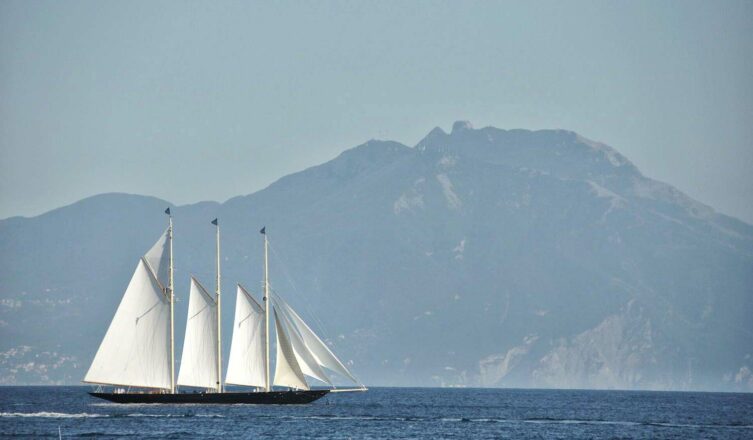
A city of contrasts
Naples is not an unambiguous city. It is neither beautiful nor ugly at first glance, although it can be both. And in fact it is! It is beautiful and ugly at the same time. You will meet a lot of delightful places here, but there will also be those that you will pass through at a faster pace. The paradox is that the first impression is not the one you remember. On my own example, I know that with time I am more willing to return with memories to photos and places that I did not immediately like. More willingly than to those that were undisputedly pretty or even very pretty.
There is something about Naples that visiting it lasts much longer than the stay itself. The sightseeing of Naples remains in your mind long after you return home.
I really think Naples should be visited twice. Your first visit should give you a chance to gather as many impressions as possible. This would create a huge baggage, a great mixture of memories, even those with which at first you will not know what to do with. Just collect as much as you can and take your time. How much? I don't know. You will feel it yourself. You will be amazed at how different your memories of Naples will become over time and how much you will start to miss this city. Because you will miss it for sure.
Then it's time for a second visit. A visit during which you will start to taste this city without surprise and unnecessary embarrassment. Who knows? Maybe, like many travelers who return here regularly, it will turn out that you just fell in love with Naples? Very likely!
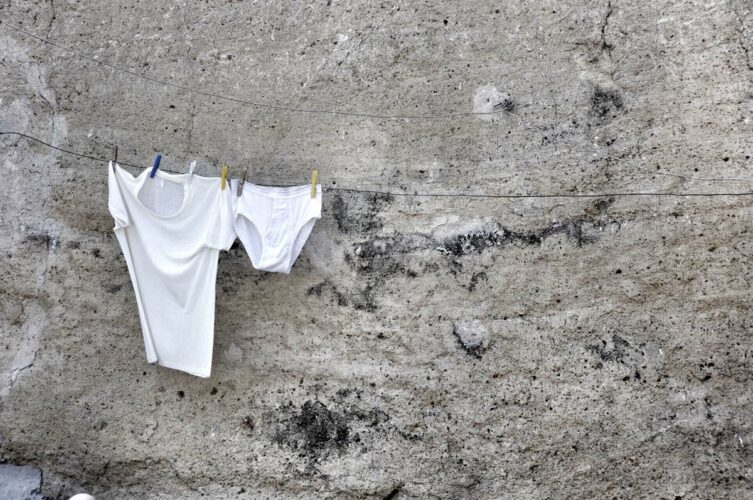
Naples Travel Guide
But first, gather your impressions and do not regret anything. Walk, taste, look and enjoy Naples. The guide prepared by me will help you in this, where I tried to collect the essence of information necessary to get to know the city properly.
By the way, I would like to add that I worked on this text so that it would not become a boring historical lecture. Therefore, there will be no tiresome introductions and introductions, no developments and sad endings. There will be a whole lot of specifics and information that you will absolutely need.
I suggest you read the post in its entirety at least once. Thanks to this, in a few steps you will get to know the layout of the city and get an idea of how to visit it. I know that at the beginning there are always many questions, but after reading this text, a lot will clear up and you will gain enough knowledge to start planning your own trip.
Of course, I also prepared my own sightseeing plan, ready to be used immediately during the trip. You will most likely like my proposal, although it is clear that there is no such thing as one best itinerary. So don't be afraid to introduce your own ideas and modify the proposed plan. In this post you will find all the necessary data to realize your own dream trip to Naples.
A step-by-step itinerary for visiting Naples
The beginning is always the hardest. So, instead of bombarding you with a list of dozens of attractions that won't tell you anything for now, let's try to do it in smaller but very logical steps:
– first, we will get to know the general layout of the city and attractions, so that we can figure out what we are dealing with at all. I will also show you how to logically divide the city into areas that can be easily visited.
– in the next step, I will post detailed maps for each of the separated areas, containing the location of all attractions and a sightseeing route that will combine everything into a complete trip
– in the last part you will find short descriptions of each attraction marked on the map, along with a set of necessary data: curiosities, practical information, links to buy tickets, opening hours, GPS coordinates for navigation, etc.
Note that each of the attractions I have described has its own unique number. You can find attraction numbers in several places. They are on the maps, in the table of contents, in the headings of the following paragraphs. Thanks to this, navigating the entry will be much easier and you will quickly reach the information you need.
There is a semi-transparent up arrow in the lower right corner of the screen. Pressing it will take you to the very top of the text (to the table of contents). This way you can easily navigate through all the text.
Use GPS coordinates
I provide precise GPS coordinates for each attraction. This may not seem particularly useful at first glance, but in practice, the exact opposite is true. Thanks to these coordinates, you do not have to stick to a specific sightseeing path. You can explore the city basically as you like.
How to use GPS coordinates in practice? Just click on the link next to them. Then the navigation will open in your phone and it will automatically determine the path to the destination, but ... you don't have to follow this path! Walk as you like, wherever you feel like, and treat the indication on your phone only as information whether you are approaching your goal or maybe you have already taken the wrong direction.
After all, visiting a city is not about walking the shortest route, but about enjoying its atmosphere. Thanks to GPS coordinates, you don't have to worry about getting lost, and at the same time you have unlimited freedom to explore.
In short: click the coordinates, walk around and check from time to time if you are moving in the right direction. Without nerves, without stress, with pleasure. Simple and devilishly effective!
I assure you that you will quickly appreciate the GPS coordinates posted here.
Tickets to attractions
The weakest point of any sightseeing plan are … ticketsand, in fact, queues to the ticket offices. You can have the best plan in the world, and the dust will fall apart at the first ticket office. When there is a queue in front of it for an hour of standing, and at the window it turns out that the nearest free entrance is in another hour or two ... what then?
Will you buy a ticket and wait? Then there is no chance to see everything that was planned that day.
Will you resign from entering and proceed as planned? Then you won't see the attraction you cared about, for which you traveled hundreds or even thousands of kilometers. Most often, long queues are in the most interesting places. The ones you come to town for. Finding yourself in such a situation is not pleasant, but fortunately there is a way to avoid it. Banal and effective!
Many venues allow you to purchase tickets in advance online. If there is such a possibility, I always use it. I buy a ticket for a specific day, and if it is necessary to choose the time of entry, I choose the one that is most convenient for me and fits my schedule. On the day of sightseeing, I skip the entire line and enter the previously purchased ticket. Often, for the holders of such previously purchased tickets, there are even separate skip-the-line entries.
In this itinerary, next to the descriptions of the attractions, I will include links to the sale of admission tickets via the Internet. It is not possible everywhere and it is not necessary everywhere, but where it can be done, you will find the appropriate link in the description.
Naples city cards and ticket packages
A very interesting option is the possibility of purchasing tickets in form city cards – [click] or ticket packages, which include already purchased admission to selected facilities, and sometimes also transport. Often, you can also save some money, because from time to time packages are available at interesting promotions (even several dozen percent). The duration of the promotion is unknown, so you have to click and check.
Interesting examples city cards – [click] and ticket packages for attractions in and near Naples can be found below. I provide prices valid at the time of writing this text and I will not update these prices. They change often and it wouldn't make sense. Just click on the link to see the current price.
Package: Underground Naples + catacombs in San Gennaro – [click] (basic price without discounts: EUR 21) includes:
– guided tour through the underground of Naples
– guided tour of the catacombs and the Basilica of San Gennaro
– entry to the catacombs of San Gaudioso and the Basilica of Santa Maria della Sanita (valid for 12 months)
Package: Pompeii + Herculaneum – [click] (basic price without discounts: EUR 43) includes:
– entry ticket to Pompeii
– entrance ticket to Herculaneum
Package: Pompeii + Vesuvius – [click] basic price without discounts: EUR 42) includes:
– entry ticket to Pompeii
– entrance ticket to Mount Vesuvius
– 90-minute guided tour around the volcano
Check the prices available: city cards in Naples – [click]
Public transport in Naples
In the sightseeing plan I have developed, I have prepared the walking routes in such a way as to make your life as simple as possible. Walking around the city according to my proposal, you will not need many means of transport. All you need is the metro (the ticket costs 1,1 EUR).
WARNING! For EUR 4,5 you can buy a day ticket, which can be used as many times as you want on the metro, buses and cable cars.
In Naples, the metro has only two lines (yellow and blue), so getting around is child's play. By the way, the layout of the station is such that everything can be done with it without any problems. I marked the location of the stations and the line numbers on the maps I prepared, so when we get to them, everything will become clear.
The metro runs from 6:00 to 23:00 every 6 to 15 minutes.
download: Naples metro map – [click] (metro lines on the plan are yellow and dark blue, the other lines visible on the plan are railway connections)
Car Rental - Naples
Arriving and exploring Naples will probably not be the only purpose of your trip to Italy. Many people from Naples start exploring the southern part of Italy by renting a car here. If this is your plan to go from Naples to explore Italy further, then you will definitely need several ways to rent a car cheaply and safely. Be sure to read the related guide car rental in southern Italy – [click]. The detailed description applies to car rental in Bari, but the principles and methodology of searching for the best offer are identical.
Naples - planning a city tour
To begin with, I have prepared a map that will instantly show you what area of the city we will be visiting and how the attractions are spread out. This is the key to further consideration and building a sensible plan.
I marked four areas on the map:
- Old Townthe historic center of the city. This is the main sightseeing area where most of the key, but certainly not all, attractions worth seeing are located. The length of this area is about 2 km. It doesn't seem like much, but due to the density of must-see sights, visiting the Centro Storico will take you most of the day or even a whole day
- San Ferdinando, a district located on the waterfront. Its attractions are located close to each other, and some of them can be seen practically standing still 🙂 of course, unless you feel like going inside. Exploring this area will take you half a day at most, and it can and should be combined with the next area adjacent to it
- Spanish Neighborhoods which is simply the Spanish Quarter. A characteristic and at the same time iconic part of the city, creating a specific atmosphere of Naples, which cannot be compared to anything else. Narrow and cramped streets filled with various lumber, small craft workshops, shops in every hole, neglected, dilapidated tenement houses ... Walking through the historical center, you can think that it is also here. Oh, no no!!! Quartieri Spagnoli offers these attractions in a much greater concentration. It is like a thick essence brewed from the Neapolitan climate. Set aside half a day to explore Quartieri Spagnoli and spend some time here, just quietly watching the bustling life here.
- catacombs the famous catacombs of Naples. Of course, there is no such district here, and I came up with the name of the area for my own needs. There are two necropolises worth seeing here (if someone likes to visit necropolises) and this is the only area that cannot be reached by metro. You have to walk (or take other transport: bus, taxi) about 2 km one way from the northern part of Centro Storico. Visiting the catacombs will take you about 2-3 hours, but you have to add the walk and return to the subway.
Naples - map of tourist attractions
Now that we know more or less what, where and how, it's time for the next step and more detailed planning of sightseeing.
Look at the next map.
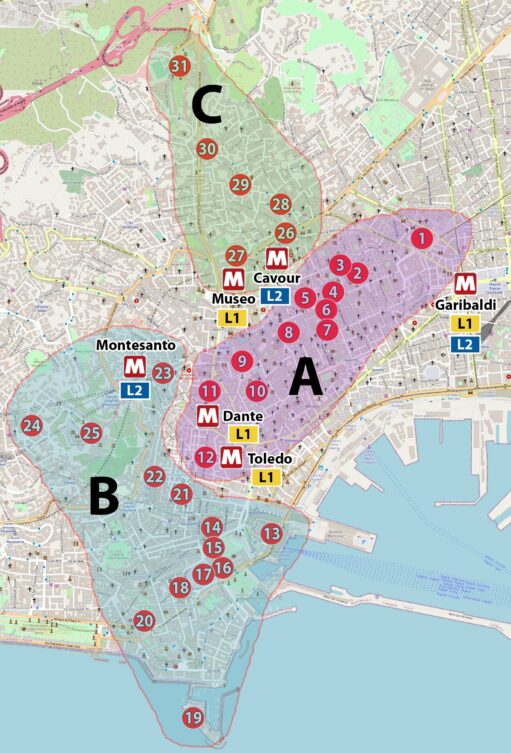
This time I marked on the map the detailed location of all the attractions I propose in the form of markers with numbers (their more detailed descriptions marked with the same numbers can be found later in the text). In addition to the attractions, you will also find the approximate location of the metro station (letter M). Next to the subway marker, I placed the name of the station and the numbers and colors of the lines that stop there (L1 - yellow and L2 - blue).
I assume that this particular map will please you very much, because on it you can see everything clearly. Clicking on the map will open the image in higher resolution, which will allow you to enlarge it further 🙂
However, I think that the next maps prepared by me in the further part of the text will please you at least as much, and maybe even more.
Practical note:
Metro lines connect in two places: at the Garibaldi stop and partly at the interconnected Museo and Cavour stops. Only in these two places you can change from one line to another, and in the case of the Museo and Cavour stations, you will have to walk a bit through the corridors that connect the two stations.
On the map, I have highlighted three colored areas, additionally marked with capital letters A, B i C. As part of these three areas, I have developed three detailed, independent sightseeing routes that you can freely mix, implementing them in a convenient order. Thanks to this, the plan gains flexibility and may be useful to a larger group of people (I hope so).
Area A covers mainly the area of the historical center, B area is a combination of the waterfront district, the Spanish district and the castle hill, a C area are the catacombs and attractions that are on the way to the catacombs.
Of course, nothing stands in the way of making a completely different division and exploring the city in your own way. By creating your own itinerary, you will get to know all the attractions better, and later sightseeing will be even more enjoyable.
Visiting the historic center of Naples (Area A)
We will start by describing the area where most travelers start to get to know Naples. These will be attractions located mainly in the area of the historic city center.
First, of course, the map, and then the rest of the information.
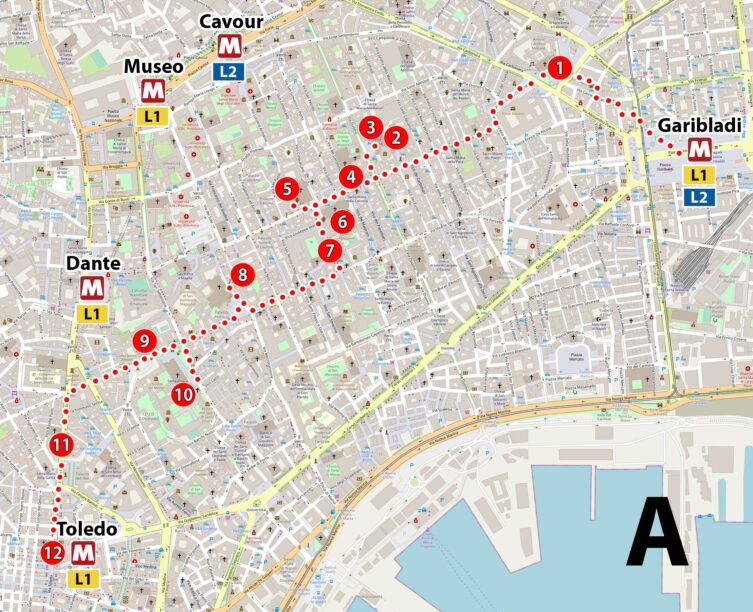
The sightseeing route has been designed so that its beginning and end are close to the metro station. Thanks to this, you can implement this plan regardless of the location of your accommodation. If you have a subway near the hotel, you just go to the beginning of the sightseeing route and start its implementation. At the end you will be close to the station again and you can easily return to your hotel. I will say more! Thanks to such planning, you can live even outside of Naples and in no way does it interfere with the implementation of my proposal 🙂
The entire route is less than 4 km long and, as far as the length itself is concerned, it is theoretically not very demanding (it runs almost entirely on a flat surface). However, you should not forget that there are several objects on the way that you have to enter (tickets !!!), and visiting them requires further walking (e.g. Naples Underground). In practice, walking this short route at first glance and visiting all the attractions should take you most of the day.
If you decide not to visit some of the proposals and you have some space, consider combining this route with a visit to the catacombs (area C), which does not take a whole day to visit, but only a few hours.
1. Capuan Gate (Porta Capuana)
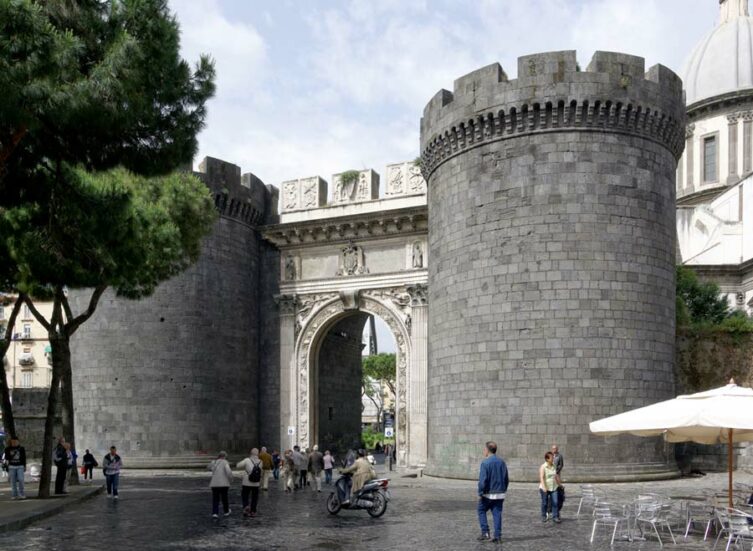
photo: Berthold Werner according to CC BY-SA 3.0
We start the tour at the Garibaldi metro station and head to the gate about 400m away Porta Capuana. Through the Porta Capuana gate, one of the most important roads in this part of Italy led to the city: the royal road to Apulia.
Near the gate is a rare fragment of the city in Naples, which has remained unchanged since the XNUMXth century. It consists of buildings clustered around an old road, which is now one of the streets of the city: Via Sant'Antonio Abate. By the way, I would like to add that Sant'Antonio Abate street is also a famous, historical daily market that stretches along the entire street. For the willing and curious, I attach a map showing how to get from the gate to Via Sant'Antonio Abate.
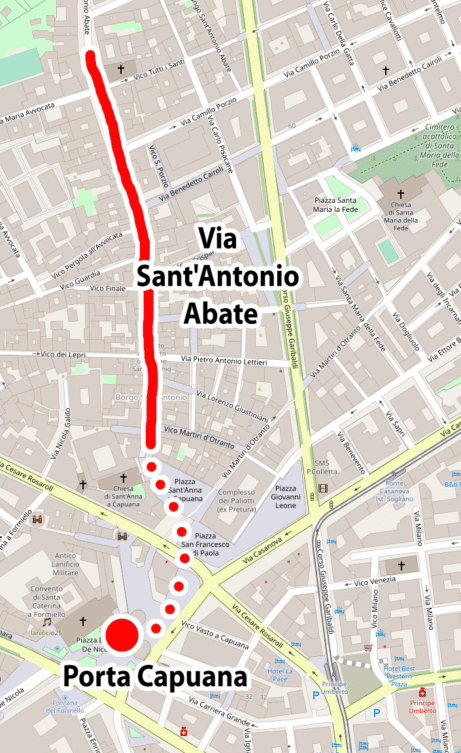
map base: openstreetmap.org
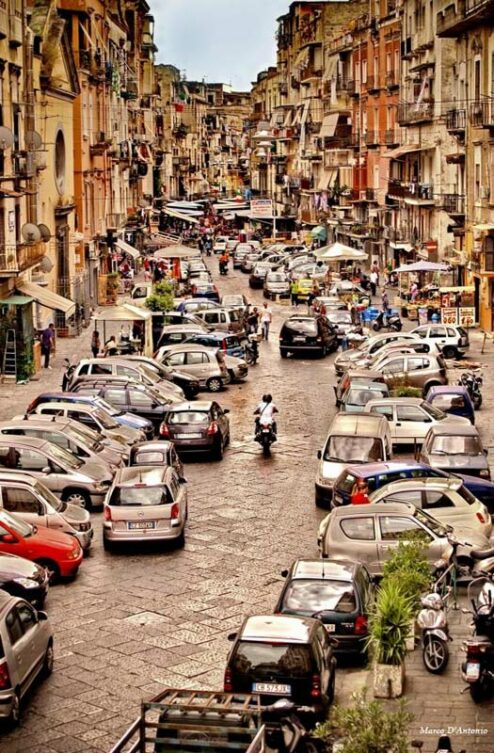
photo: Mark1000 (Marco Antonio) according to CC BY-SA 3.0
Currently, the gate is more associated with a triumphal arch, because it stands completely alone and no walls reach it. Once, however, it was part of the Aragonese defensive walls surrounding the city. The remains of the walls in the vicinity of the gate, along with preserved fragments of the neighboring defensive towers, can be found here to this day. They have grown into the city and have been tightly enclosed with newer buildings, currently creating one organism.
One of the towers looks funny, on top of which there is a small house. I admit that I have not found information about how and when it was built, but looking at the finials of other towers in Naples (they are flat and there are no houses on top of them), it is hard to assume that this house has been here forever. As a curiosity, I'm posting a photo from three-dimensional Google maps.
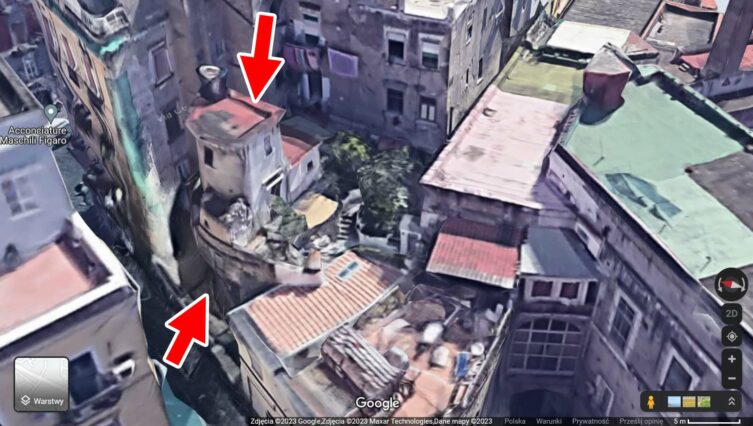
Source: Google Maps
Porta Capuana, GPS coordinates:
40°51’15.9″N 14°15’55.7″E
40.854419, 14.265478 - click and route
Via Sant'Antonio Abate, GPS coordinates:
40°51’25.7″N 14°15’56.5″E
40.857131, 14.265680 - click and route
A tower with a house on top, GPS coordinates:
40°51’19.5″N 14°15’51.3″E
40.855404, 14.264239 - click and route
2. Cathedral of St. January (Cattedrale di San Gennaro, Duomo di Napoli)
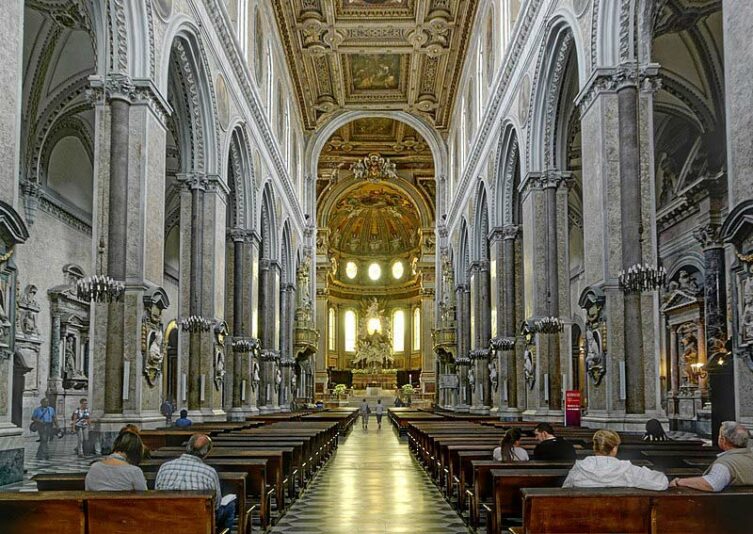
photo: Berthold Werner according to CC BY-SA 3.0
One of the most beautifully decorated churches in Naples. It consists of the main building and two side chapels added later.
The main building was built at the turn of the XNUMXth and XNUMXth centuries. It was erected on the site of the partially demolished Stefania Basilica, which has existed here since the XNUMXth century.
Curiosity:
After the construction of the cathedral was completed, there was an equestrian statue in front of it. It has stood here for centuries before the demolished basilica. And everything would be fine if not for the legends associated with this monument. Local residents believed that Virgil carved the monument with the help of witchcraft, and that therefore the monument had the ability to heal horses. For Cardinal Filomarino, this story proved too much to bear, and he ordered the statue to be dismantled. Eventually, the figure was melted down, and the bronze thus obtained was used to make the bells, which hang in the cathedral to this day.
For the inquisitive:
The cathedral houses the relics of St. Januarego (a bottle containing his blood). Twice a year (in May and September) the relics are put on public display. If the blood is then in the form of a liquid, Naples will enjoy abundance. Otherwise, something bad will happen (as in the XNUMXth century, when the blood congealed and the city was struck by an epidemic).
After entering the cathedral, you can continue to the next two objects. You enter it from inside the cathedral. To the right is the entrance to the Reale Cappella del Tesoro di San Gennaro (Royal Chapel of the Treasury of St. Januarius). The ornate chapel houses and displays works of art and gem-studded jewelry, including a bishop's miter and silver busts. Admission is paid.
On the left you will find the entrance to the Basilica of Santa Restituta, about which I will write more in the next section (3)
check out: tickets to San Gennaro – [click]
Cathedral of St. Januarius in Naples, GPS coordinates:
40°51’08.8″N 14°15’33.4″E
40.852443, 14.259263 - click and route
3. Santa Restituta Basilica
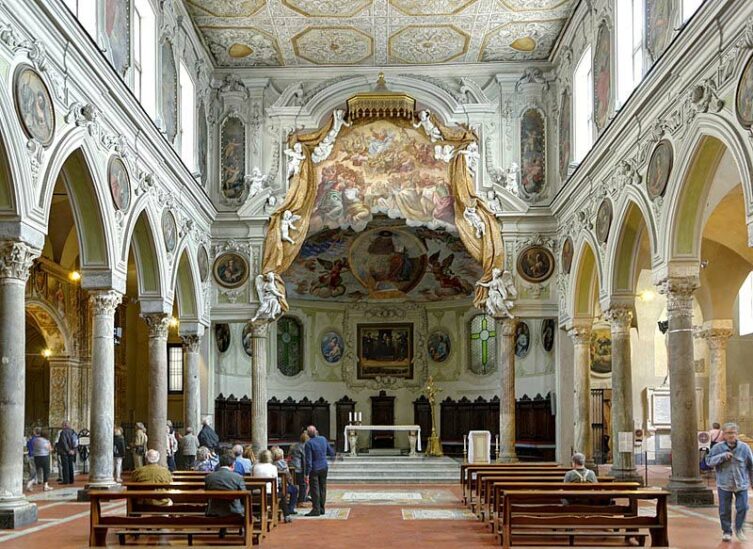
photo: Berthold Werner according to CC BY-SA 3.0
The Basilica of Santa Restituta is one of the oldest, preserved to this day, early-Christian buildings. The interior decorations in the baptistry room have also been preserved. Originally, the church had five naves and probably also five entrances, so it was much larger than it is today.
The preserved fragments of the building and decorations (including mosaics) come from the XNUMXth and XNUMXth centuries AD.
The basilica is entered from inside the Cathedral of St. January (left). Entrance to the basilica is free, but you have to pay to enter the baptistry room.
Basilica of Santa Restituta, GPS coordinates:
40°51’10.6″N 14°15’33.6″E
40.852934, 14.259325 - click and route
4. Madonna with a Banksy gun
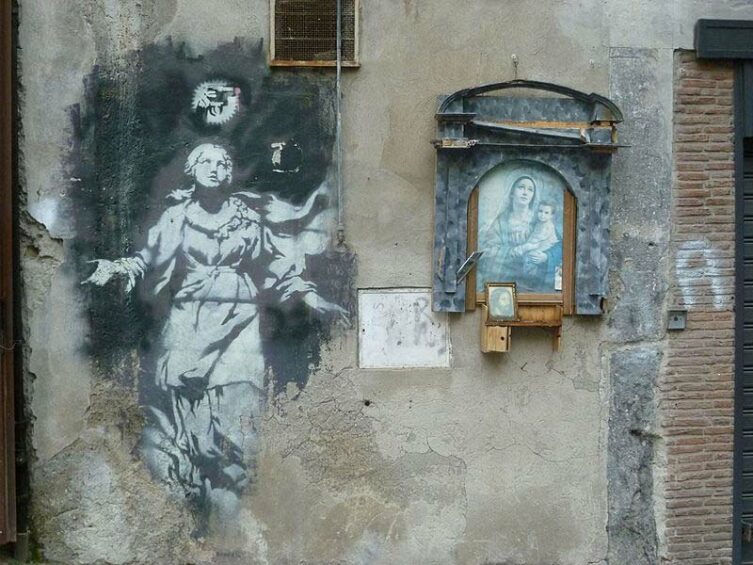
photo: Antoine Pitrou according to Free Art License 1.3
One of the works of perhaps the most famous street artist in the world is on a wall in the historic center of Naples. Until a few years ago, the work was available without any security. After a significant increase in interest in the artist himself and his work on Madonna with a Pistol, it began to get crowded and there was fear that the work would be destroyed.
Currently, the work is enclosed in a special cabinet and can only be admired through the glass.
Madonna with a Banksy gun, GPS coordinates:
40°51’05.8″N 14°15’31.7″E
40.851607, 14.258797 - click and route
5. Napoli Sotterranea ANS (underground Naples)
When Naples was founded, there were actually two cities. This was due to the underground rock of volcanic origin (the so-called tufa), which was perfect for construction.
Where did the building materials from which the next buildings come from come from? Underground! The first quarry undergrounds were created by the Greeks as early as the XNUMXrd century BC. Rock blocks of appropriate size were separated from the solid rock under the ground, mined to the surface and used for construction. The city grew on the ground, and underground corridors and voids were created, most of which were used as cisterns for storing water. Later (during the times of the Romans), mining was carried out in a more planned manner and, by the way, a well-thought-out system of connections was created underground to control the flow of water, i.e. aqueducts.
Over time, the system grew larger and gained new functions. There were roads, a market and even a theater in the underground.
The system of caves and undergrounds in Naples extends under the entire area of the historic city center, and a large part of them still remains unexplored. It is said that if you want to know how big the caves are under your feet, look at how big the buildings are before your eyes. The larger the building, the more materials needed to build it, and thus the larger the hole in the ground under the building. Most buildings in Naples thus had direct access to the underground system and had their own underground water reservoir. To this day, in some houses, the descent to the underground is blocked by a bed or a wardrobe, so that children do not accidentally venture into unknown and dangerous underground areas.
So when walking around Naples, be aware that 40 meters below your feet there is a second city, which Naples people often call the "mirror image" of what is seen on the surface.

clicking on the picture will take you to the view on Google Maps
source: Google Maps
Due to the theoretical multitude of entrances and the relative ease of access to the tunnels from many unauthorized places, a system of licenses has been introduced in Naples authorizing the access and guiding tourists around the underground. Currently, the most popular are the services of two associations with such a license:
- the first one is this Associazione Napoli Sotterranea - ANS (marker number on the map 5)
- the second association is LAES (marker number on the map 32) - a more detailed description can be found in the further part of the text.
check out: entrance tickets to Napoli Sotterranea (no. 5) – [click]
Napoli Sotterranea (underground Naples - No. 5 on the map), GPS coordinates:
40°51’04.6″N 14°15’24.4″E
40.851281, 14.256766 - click and route
6. Underground city under the church of San Lorenzo Maggiore
Probably the most interesting example of the layered structure of Naples is what we can see when visiting the church and monastery of San Lorenzo Maggiore. Currently, the building also serves as a museum, exhibiting on three floors a lot of interesting exhibits related to San Lorenzo and the broadly understood history of Naples. The most interesting, however, is underground.
It is still hard for me to imagine how it went in practice, but the effect is that the church of San Lorenzo Maggiore was literally erected on the previously existing Greek agora, Roman forum and commercial building (!!!), which was originally two stories high. Currently, the ground level is more or less at the level of the second floor from the XNUMXst - XNUMXnd century BC macellum (i.e. the aforementioned commercial building).
.
The find is quite recent, because it was opened to the public only in 1992, after 25 years of excavations. So far, more or less half of the roofed building has been excavated, but the impression is electrifying. You enter the basement of the church, and there is a second city: a commercial building, a street, a fragment of the agora ... there is a slight shock!
check out: tickets to San Lorenzo Maggiore and underground – [click]
Underground under the church of San Lorenzo Maggiore, GPS coordinates:
40°51’02.6″N 14°15’27.5″E
40.850733, 14.257649 - click and route
7. Via San Gregorio Armenia
After exploring the underground, it's time to breathe some fresh air. If you have chosen to visit the previous point of the trip, i.e. San Lorenzo Maggiore, you have already walked a few steps down San Gregorio Armeno and you more or less know what awaits you.
On this street there is a famous center of nativity scenes and arts related to nativity scenes. About 200 meters long, a very narrow street, squeezed tightly between buildings, along its entire length is lined with stalls filled to the brim with nativity scenes. Ba! There are whole landscape scenery, genre scene installations and countless figurines, not only for the Christmas occasion (celebrities, athletes, artists, politicians and famous personalities are for sale here in the form of eye-catching figurines). It is mostly handmade, small masterpieces, often unique and inimitable.
Generally, everything you buy here is suitable for inserting into a crib or displaying separately. Things are not cheap, but some are really hard to resist. You can spend any amount of money here if you want.
You can watch for free 🙂
I must admit that it is a lot of pleasure to watch these handmade wonders.
Of course, the apogee of popularity, the breadth of the offer and ... the price level falls on the period before Christmas.
A street of Christmas nativity scenes, GPS coordinates:
40°51’00.3″N 14°15’28.2″E
40.850081, 14.257821 - click and route
8. Sansevero Chapel and Christ under the Shroud (Museo Cappella Sansevero)
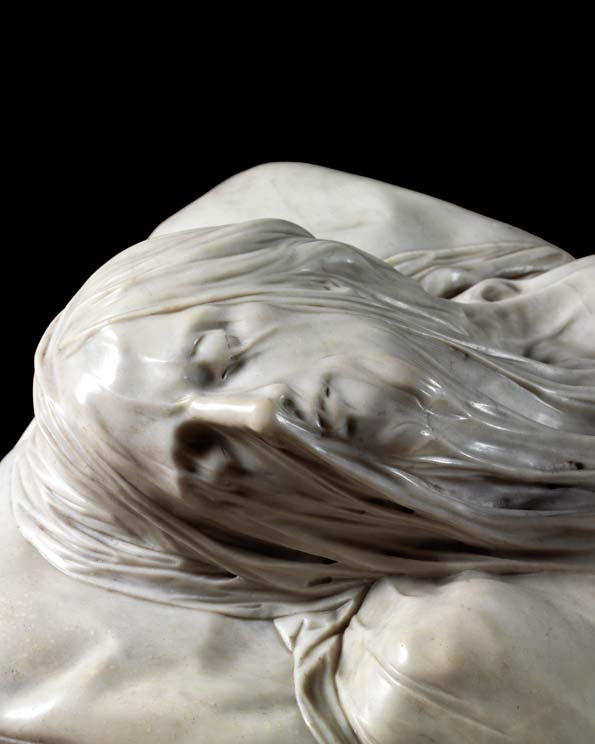
photo: David Sivyer according to CC BY-SA 2.0
Without a doubt, this point of the trip should be considered mandatory. In the chapel there is a work of art that will impress even the most art-resistant individuals. Guaranteed!
The life-size body of the dead Christ hidden under a delicate shroud is carved out of a single piece of marble. Even looking at this work closely, it is difficult to understand how it is possible that the soft, translucent shroud is not a real canvas, but a stone sculpture. Undoubtedly, we are dealing here with something unusual and unique in the scale of the entire history of art.
The sculpture is frequently visited by artists from all over the world who come to Naples to see the technique of its execution. To this day, however, no one has matched the original, and the master of Italian classicism, Antonio Canova himself, said that he would give ten years of his life to be the author of this work.
No photography is allowed inside, so here are links to photos by other authors:
- interior of the Sansevero Chapel – [click]
- Christ under the shroud – [click]
Christ, who is the central part of the exhibition, is not the only outstanding work exhibited in the chapel. It is surrounded by several other sculptures. Visitors to the chapel, being very impressed with "Christ under the shroud", often pay less attention to it. I urge you not to skip at least two of them under any circumstances: a man trying to free himself from the net (i.e. "Disinganno" by Francesco Queirolo) and a woman covered with a veil (i.e. "Pudicizia" by Antonio Corradini.
Standing at the foot of the sculpture of Christ, behind his head on the right side against the wall you will find "Disinganno", and symmetrically on the left side there is "Pudicizia").
One more surprise awaits you after going down to the chapel underground. There, in display cases, the so-called anatomical machines, i.e. skeletons of a woman and a man, with a preserved circulatory system that densely entwines both figures. The sight is slightly shocking, and many legends have grown around anatomical machines over the centuries.
One of them even says that the skeletons are a pair of servants who worked for Raimondo di Sangro, i.e. Prince Sansevero, responsible for the construction of the chapel. The prince was an extremely colorful and controversial figure, and at the same time highly talented and well-educated. He conducted numerous experiments, incomprehensible to most people, and one of them was to inject a metallising substance into the servants' bodies, which, after dissolving in their blood system, was to lead to the metallization of the veins that formed it.
This theory was finally refuted only in 2007 (!!!). Research conducted by the American Institute for Conservation of Historic & Artistic Works in Washington, D.C. has shown that the circulatory system is not the effect of metallization, but was created as an extremely precise handwork (by the doctor Giuseppe Salerno, under the supervision of the Duke of Sansevero), made using wires, fibers and colored wax.
It still remains an unexplained fact that at the time when this model, which precisely reproduces the circulatory system, was created, the knowledge that would allow it to be made with such a degree of detail was not yet available.
The San Severo Chapel and the Shrouded Christ are highlights particularly at risk of shortage admission tickets. If there is a problem with availability and purchase, you can try to join one of the guided tours that have guaranteed entrances (they buy large batches of tickets in advance). The San Severo entrance is then one of the sightseeing points.
check out: group tour with a guide and entry to the San Severo Chapel – [click]
San Severo chapel and Christ under the shroud, GPS coordinates:
40°50’57.3″N 14°15’17.4″E
40.849245, 14.254836 - click and route
9. Gesu Nuovo (New Jesus) Church
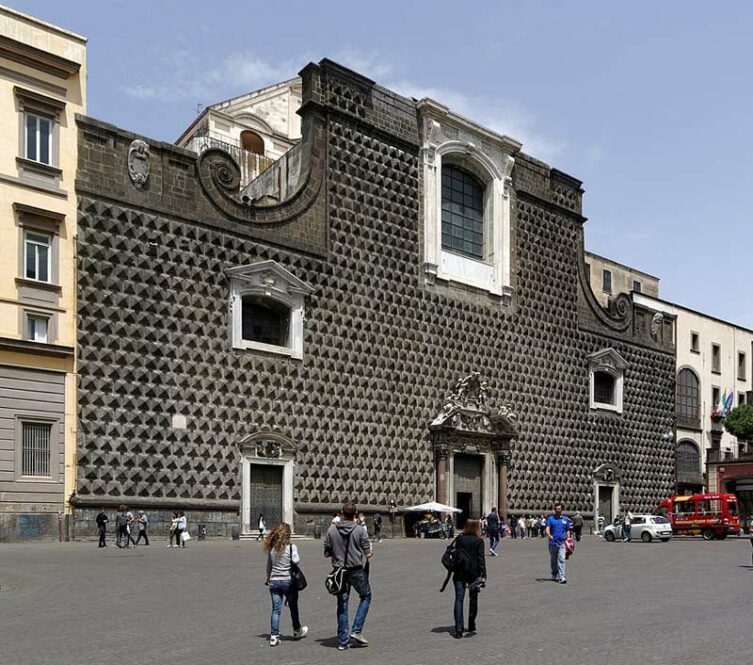
photo: Berthold Werner according to CC BY-SA 3.0
The building of the Gesu Nuovo church has quite an interesting history, because before it became a church, it was a palace (it was called Sanseverino Palace)! It was commissioned by Roberto Sanseverino, the Duke of Salerno, and was confiscated along with all property as a result of the political activities of the Sanseverino family (they sided with the rebels during the 1547 uprising against Pedro de Toledo, Viceroy of Spain).
For me, this is a good excuse to smuggle a short and interesting story in a few words.
In 1503, the Spaniards, competing for influence with the French, took full control of the kingdom of Naples. Naples became an essential element of Spanish power. In its area, a Spanish viceroy (Pedro de Toledo) was quickly appointed and made him responsible for supervising the area of the kingdom.
The rule of Pedro de Toledo was strict, but from the point of view of the Spaniards, it positively influenced the development and economic strength of the city (in 1550, Naples reached the size of the second largest city in Europe after Paris).
As part of its changes, Toledo introduced in Naples e.g. summary executions, and walking around the city after dark with a gun was punishable by death. As part of the "Spanishization" of Naples, he closed the first formal association of scholars and humanists, the Accademia Pontaniana. However, when in 1547 he attempted to introduce the Spanish Inquisition to Naples, a rebellion broke out. The rich families inhabiting the area of Naples and the kingdom knew how the inquisition worked and were afraid of it. Untrue accusations against inconvenient people and fictitious trials led to sentences under which such people's property was taken away. Not surprisingly, many of the noble and wealthy supported the rebellion. Eventually, the Spanish viceroy withdrew from introducing the inquisition, but the rebelling families were punished ... with confiscation of property. Thus, a rebellion caused by fear of losing their wealth led them to lose their wealth. This is exactly what happened to the Sanseverino family and their palace in Naples.
The confiscated palace was bought by the Jesuits for 45 ducats and they decided to convert it into a church. The interior of the church was decorated on a grand scale and it can be said that it has become one great work of art (mainly painting and sculpture).
Inside the church there are several chapels, but the most interesting is the Chapel of the Visitation, where the remains of a lecturer at the University of Naples are kept: Joseph Moscati.
Moscati is the first modern physician to be called a saint. He was famous for his disinterestedness, the ability to accurately diagnose and effectively treat hopeless cases. There is a votive wall in the chapel, with thanks from healed patients.
Gesu Nuovo Church, GPS coordinates:
40°50’50.5″N 14°15’07.2″E
40.847357, 14.251993 - click and route
10. Monastery of St. Clare (Monastero di Santa Chiara)
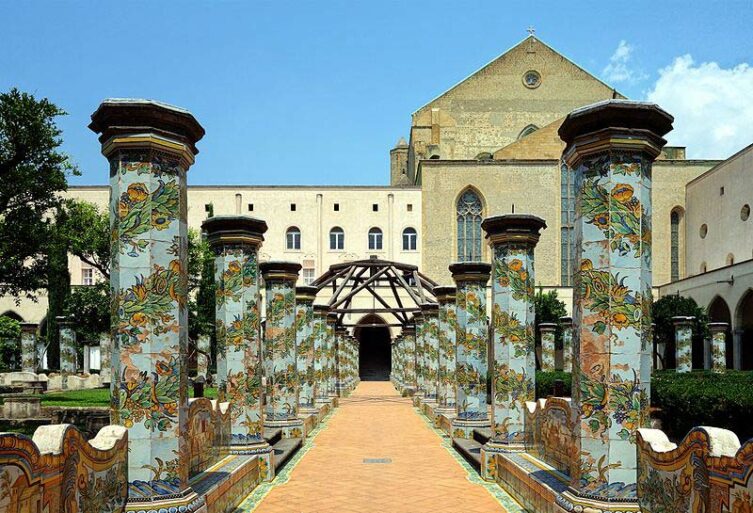
photo: Velvet based on the principles CC BY-SA 3.0
Directly opposite the Gesu Nuovo Church is the Monastery of St. Clare, and basically a monastery complex, which consists of a basilica, a tall, free-standing bell tower and monastery buildings, which currently house a museum. Once richly decorated, the basilica now has a rather austere interior, due to the Allied bombings during World War II (the air raids took place in August 1943). Bomb explosions followed by extensive fires nearly razed the building to the ground. Although the basilica was rebuilt in the 50s, it was given the decor and form it had in its early years (built in the XNUMXth century), before Domenico Antonio Vaccaro took care of its reconstruction and decoration in the XNUMXth century.
The main memento of the activities of Domenico Antonio Vaccaro, and at the same time the greatest treasure of the monastery complex, are the cloisters hidden at the back and the courtyard surrounded by them. Most visitors come here just for this courtyard. Divided into four parts by two intersecting alleys, it creates a quiet asylum in the middle of a crowded city, giving a bit of respite during sightseeing. I advise you to take advantage of the opportunity and relax for a while, enjoying the decorations made of colorful tiles, which look beautiful in souvenir photos. The whole idyllic atmosphere of the courtyard is complemented by citrus trees growing here. If you come here at the time when they have fruit on them, the level of delight will go up another three levels 🙂
To reach the courtyard, you need to enter through the gate next to the high, standing bell tower, and then follow the left, outer wall of the basilica to its end.
Monastery of St. Clare (Monastero di Santa Chiara), GPS coordinates:
40°50’50.0″N 14°15’09.3″E
40.847210, 14.252587 - click and route
11. Via Toledo
Via Toledo is widely recognized as the most representative street of Naples. If you managed to read the description to point (9), you will easily associate the name of the street. It comes from the name of the Spanish Viceroy Pedro de Toledo mentioned there, who reigned here when Naples was under the control of the Spaniards. It was him who, thanks to the Italian architect he employed (Ferdinando Manlio), gave the street its current character, turning it into a prestigious avenue with beautiful buildings. In later centuries, the street was of course modified (higher buildings were erected), but it retained its prestige and commercial character.
Mainly Spaniards settled in the street and its surroundings (in fact, the most prestigious place in the city was reserved for them by the king). Hence the name of the district, which we will still have to walk around: the Spanish Quarter.
It is worth taking a short walk on Via Toledo, especially since it is not long. It is approximately 1200 meters long and connects two important squares: Piazza Dante and Piazza Trieste e Trento. If you are visiting Naples according to my plan, the route will lead you through a short section of the street. If you still have the strength after a day of sightseeing, instead of going straight to Toledo Metro Station (the next stop on your tour), go first to Dante Square and then take Via Toledo to Toledo Metro Station. Everything is well illustrated by the map prepared by me:
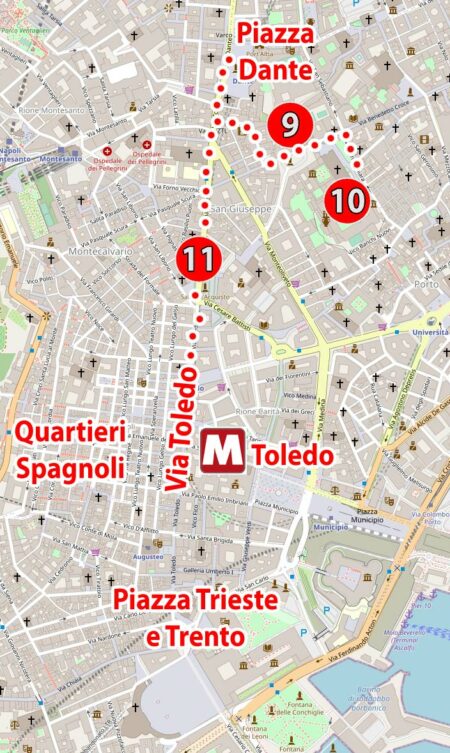
Landmark on Via Toledo, GPS coordinates:
40°50’40.1″N 14°14’56.8″E
40.844471, 14.249098 - click and route
12. Toledo (subway) - art station
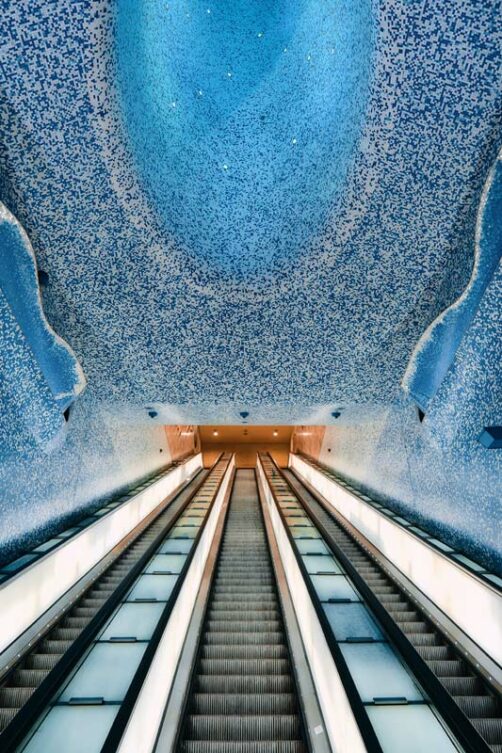
photo: Mario Esposito
Toledo is a unique station. Just enter it and everything will become clear. Someone, once in Naples, had the idea to allow artists to give the stations a unique look, in accordance with selected artistic visions. And it wasn't about spray painting on the walls, but about an extensive, comprehensive vision of artistic public space. There were volunteers, there was money, and this is how the project "Plan One Hundred Stations" was created, which is commonly called Art Stations. As part of this project, 11 stations have already gained an artistic look, including the Toledo station.
In this way, Naples, which can boldly compete for the title of the most polluted city in the world, is also the city with the prettiest and cleanest metro stations. Paradox? This is Naples!
The currently available art stations in Naples are: Dante, Garibaldi, Materdei, Municipio, Museo, Salvator Rosa, Rione Alto, Toledo, Università, Quattro Giornate, Vanvitelli.
Entrance to the Toledo metro station, GPS coordinates:
40°50’33.3″N 14°14’56.4″E
40.842572, 14.248993 - click and route
Naples Sightseeing - Day Two (Area B and Area C)
The second day of sightseeing is very long and full of attractions. If you ran out of strength yesterday to walk Via Toledo (11), you can try to make up for it today (according to the map I posted earlier, in point 11 - Via Toledo). Instead of taking the metro to the Toledo station scheduled to depart on day XNUMX, you can go to Dante station. Dante station is located at Dante Square. From here you walk via Via Toledo to Toledo station and continue as shown on the map below showing the itinerary for the second day.
The walking map for this day consists of two parts: B area and C area. It's just much more readable that way. Sightseeing covers a large part of the city, so the attempt to put everything on one map obscured the situation.
I decided to combine area B and area C in one day, assuming you only spend two days in Naples. If you have more time, you can visit these areas separately.
The distances to be covered in both areas are as follows:
- B area: to walk about 9 - 10 km
- C area: about 4 km to walk
Area B - Visiting San Ferdinando, Quartieri Spagnoli and Naples Castle Hill
Let's take a closer look at the map presenting the first part of the walk, located in area B.
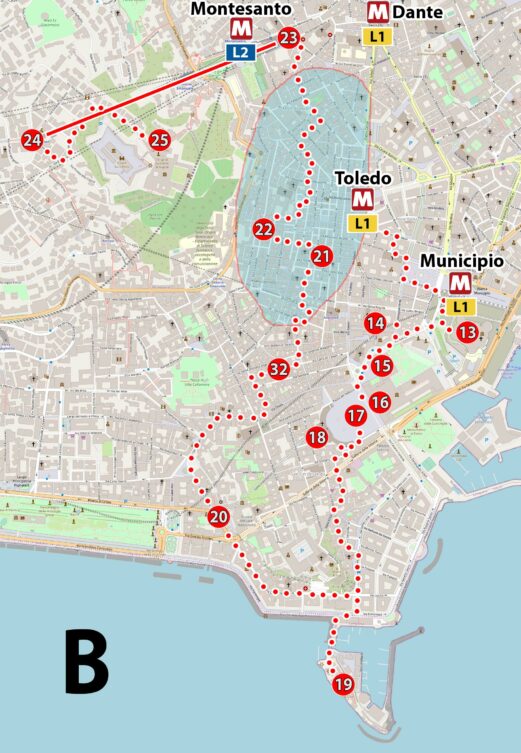
The closest to the first attraction of the day, i.e. the New Castle (Castel Nuovo, on map no. 13), is the Municipio metro station. It is so close to the castle that you can even see parts of its walls inside the metro station.
The first six attractions are located very close to each other, and four of them (15, 16, 17, 18) can be seen even without moving, because they are concentrated around one large square Piazza del Plebiscito. The real walking starts only after that and leads through the Spanish Quarter (21, 22), for which it is worth taking a little more time. The last part of this part of the walk is a train trip to the castle hill (a straight line connecting points 23 and 24 on the map) and a walk towards the viewpoint. The return takes the same route to point 23, where the metro station (Montesanto) is located. From here you can take the metro (line L2 - blue) to Cavour station, which is the starting point for exploring area C.
Area C - visiting the catacombs and attractions north of the historic center of Naples
The catacombs cannot be reached by subway. You have to get there by other means of transport (taxi, bus numbers: 168, 178, 204, 460, 460A, C63, C67, 3M) or walk about 1,8 km one way from Cavour metro station. I assume that at least in one direction you will choose the option of walking, so I led the route so as not to extend it artificially. Fortunately, however, the walking route runs alongside other attractions that will make your way more pleasant.
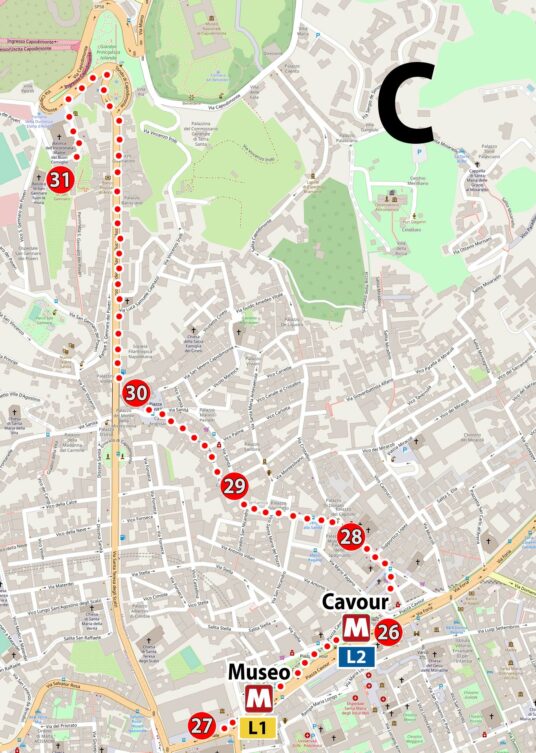
I suggest keeping the following order of visiting: 26, 28, 29, 30, 31, leaving number 27 (i.e. the National Archaeological Museum) at the very end. However, take into account that doing everything in one day (areas B + C) you will run out of time or strength at the museum.
13. Castel Nuovo
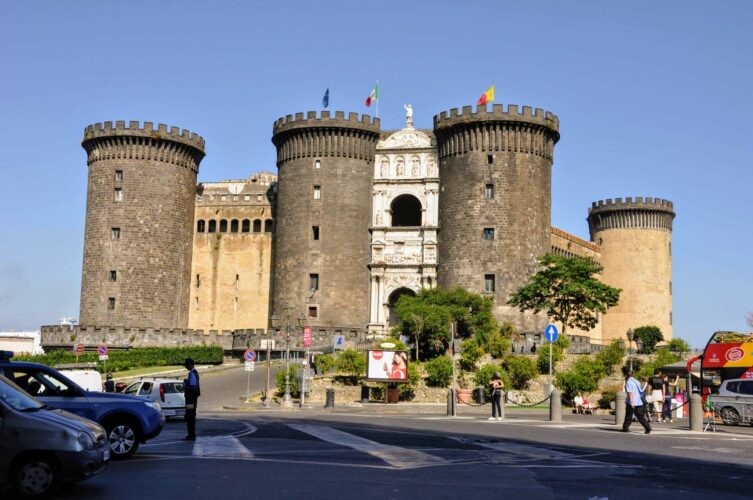
As the name suggests, the capital of the Kingdom of Naples was …. Palermo. Yes Yes! Until the thirteenth century, and more precisely until 1266, the command center of the Kingdom of Naples was in Sicily. The change came with the accession of Charles of Anjou to the throne. He decided to move the capital of the kingdom to Naples, while commissioning the construction of a new castle (hence the name Castel Nuovo). The castle was supposed to have the right size, momentum and … be close to the sea.
Did the architects meet the king's requirements? Check it out! I will only add that for various reasons the castle remained uninhabited until the death of Charles of Anjou. It became the focal point of the kingdom only after the accession to the throne of the king's son, Charles II the Lame.
New Castle (Castel Nuovo), GPS coordinates:
40°50’18.3″N 14°15’09.0″E
40.838428, 14.2524993 - click and route
14. Umberto I Gallery Naples (Via Toledo)
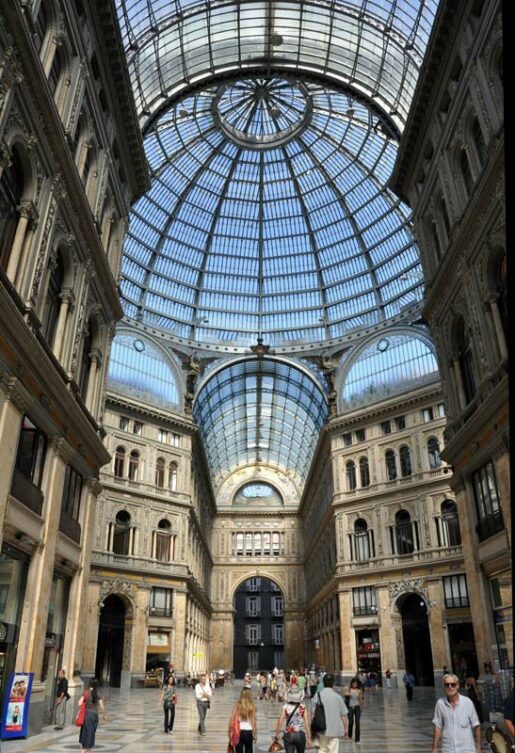
For shopaholics, this will be the highlight of your visit to Naples. A huge and at the same time beautiful shopping mall, covered with an openwork and glass roof similar to the gallery in Milan. Here you will meet the best and most expensive brands in the world. If you suffer from excess cash, you will quickly clean your wallet and credit cards from the money remaining on them.
However, regardless of the wealth of the wallet, it is worth taking a short walk around the shopping mall, if only to admire the exquisite architectural style of this building.
The gallery is cross-shaped and has four main entrances and exits. One of them overlooks the already familiar Via Toledo.
Umberto I Gallery Naples, GPS coordinates:
40°50’18.5″N 14°14’58.2″E
40.838482, 14.249485 - click and route
15. San Carlo Theatre
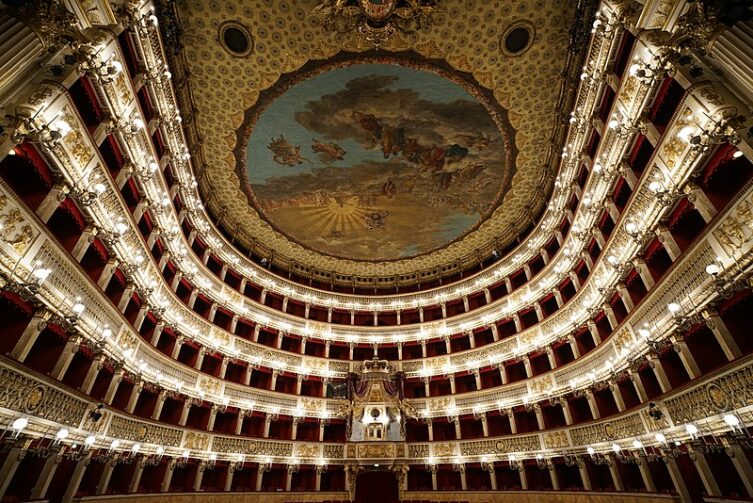
source: Wikipedia in the Public Domain
The opera (and ballet) stage at the San Carlo Theater has been operating continuously since 1737. This makes it the oldest continuously operating opera house in the history of the world (it is several decades older than La Scala in Milan). When it was built, it was also the world's largest stage, with an audience capacity of over 3200 people (now the capacity of the auditorium has been deliberately reduced to 1386 seats). It was on this model that later the largest and most famous opera theaters were built. For almost 150 years it was the dominant scene of Italy. Its dominance ended with the unification of Italy (in 1861). The concentration of power and wealth in the northern part of the new Italian state naturally increased the prestige and popularity of La Scala in Milan. The San Carlo Theater gradually lost its importance, falling into deeper and deeper financial difficulties. In February 1816, a large part of the theater was destroyed by fire, and during World War II by bombing. Fortunately, in both cases, the theater was quickly rebuilt, restoring its proper splendour.
The Teatro di San Carlo can be visited, which, due to the beauty of the interior, I sincerely recommend. Sightseeing takes place under the supervision of a guide, and tickets are purchased at the ticket office immediately before the tour (the last known ticket price from 2022 is EUR 9).
Curiosity:
The theater has a direct connection to the royal palace located behind it. The king came to the theater without going outside, and the corridor connecting the palace with the theater exits directly at the royal box.
San Carlo Theatre, GPS coordinates:
40°50’15.8″N 14°14’58.3″E
40.837731, 14.249537 - click and route
16. The Royal Palace of Naples (Palazzo Reale di Napoli)
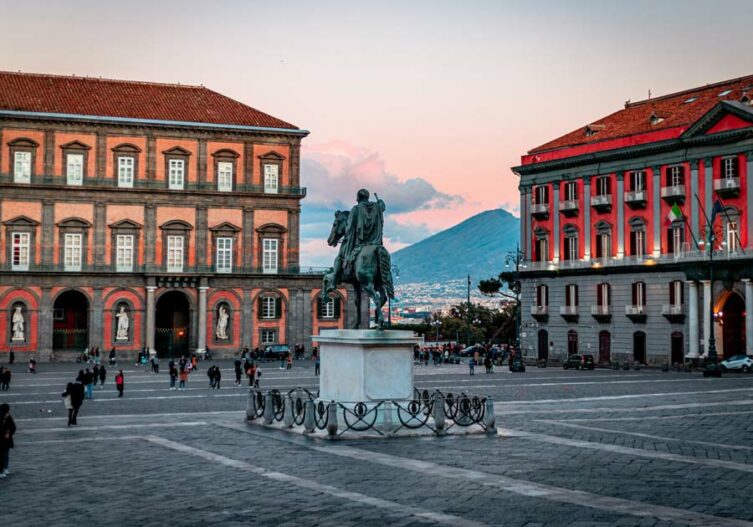
photo: Yahya Momtaz
In the place where the palace currently stands, there was previously a residence of the viceroys of Spain who ruled the kingdom of Naples. The residence, built for the Spanish Viceroy, Philip III Habsburg, was never visited, however, because Philip III never came to Naples. It was quickly decided to replace the residence with a larger, much more representative palace and in 1600 the Swiss architect Domenico Fontana was commissioned to design it. Probably the name of the designer will not tell much to most of us, but it is enough to add that he was also the architect of St. Peter in the Vatican and the Vatican Library ... and it is already known that the principals have reached for a professional of the highest quality.
The palace, built on the basis of the project, was later rebuilt, expanded and beautified many times. It has acquired an extremely sumptuous character with delightful interiors. Of course, the palace can be visited. Then you can see, among others: royal apartments, the Hall of Ambassadors, the Throne Room, the Palatine Chapel, the Hanging Garden and the Court Theater which is part of the palace.
check out: entrance tickets to the Royal Palace in Naples – [click]
Operating hours of the palace complex:
closed every Wednesday, December 25 and January 1
open on other days
The Royal Palace is open from 9.00 to 20.00
the ticket office closes one hour before the palace closes
La Galleria del tempo is open from 9:00 to 19:00
last entry at 18.00
Royal Palace in Naples, GPS coordinates:
40°50’10.3″N 14°14’57.7″E
40.836184, 14.249359 - click and route
17. Plebiscite Square (Piazza del Plebiscito)
The largest and one of the most beautiful squares in Naples. Several attractions can be seen from it at the same time (15, 16, 18) because it is surrounded by them. The name of the square commemorates the plebiscite held in 1860, under which the countries located on the Apennine peninsula were united into one large, common state: the Kingdom of Italy (now Italy).
In 1963, the square was transformed into a huge (and extremely ugly) car and bus parking lot. Fortunately, the G1994 summit in Naples in 7 forced the city authorities to renovate the square (at that time the asphalt was replaced with cobblestones), which eventually resulted in the complete closure of the square for cars. Subsequent renovations and adaptation of the square exclusively for pedestrians have made it undoubtedly one of the most interesting open places in the city. From time to time, large open-air concerts are held on the finger (Bruce Springsteen, Elton John, Muse, Maroon 5 have performed here).
Plebiscite square in Naples, GPS coordinates:
40°50’08.9″N 14°14’54.5″E
40.835792, 14.248481 - click and route
18. Basilica of St. Francis of Paola (Basilica San Francesco da Paola)
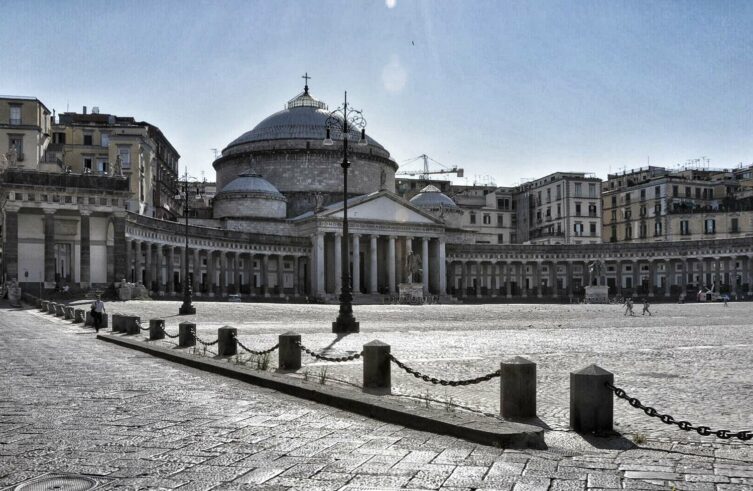
The most impressive of all the buildings surrounding Plebiscite Square is the building of the Basilica of St. Francis of Paola. Originally, it was supposed to glorify the person of Napoleon Bonaparte, and its originator and principal was the King of Naples Joachim Murat (privately Napoleon's brother-in-law). The main building was given the universally liked and ennobling form of the Roman Pantheon (a similar Pantheon is also located in Paris) combined with two arched colonnades. Honestly, it must be admitted that the building looks really impressive.
After the fall and exile of Napoleon to the island of Saint Helena, when construction was almost completed, the Bourbons regained power in Naples. They quickly completed the building and, of course, immediately repurposed it. In this way, instead of the magnificent Pantheon in honor of Napoleon, a church dedicated to the memory of St. Francis of Paola.
The basilica remains an active church that can be visited.
Basilica of St. Francis of Paola, GPS coordinates:
40°50’07.3″N 14°14’51.3″E
40.835362, 14.247572 - click and route
19. Castel dell'Ovo
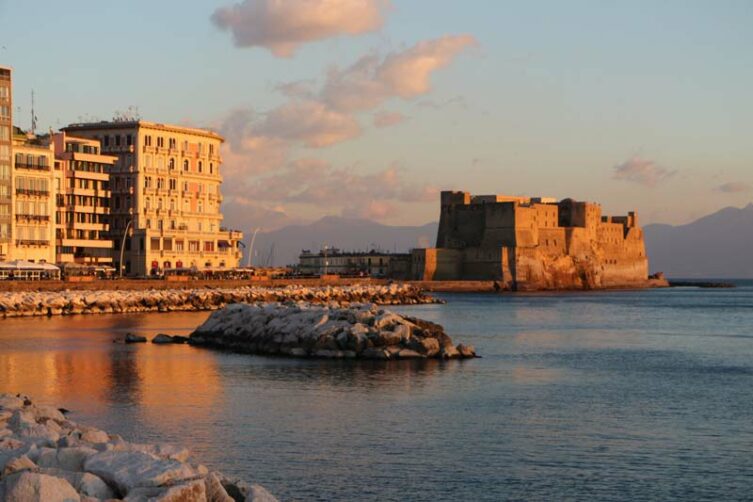
photo: Brad Weaver
The name of the castle is often translated as the Egg Castle, although it is definitely more suited to the name Castle on the Egg. Why is it better?
Castel dell'Ovo was built on a small island, which is not a single rock, but consists of two rocks connected by a natural arch. The construction of such a large and massive structure on a fragile structure near an active volcano, which generates smaller or larger earthquakes every now and then, is quite a risky project. If I were to predict whether a castle built in this way has a chance to survive a thousand years, I would say that it will not. And yet it is already 900 years old (as a fortified fortress it was built in the XNUMXth century) and is still doing well.
However, the legend says that it would not be possible if it wasn't for the magic egg placed under the castle. It has such great magical power that, supporting the brittle rock, it allows the castle to stand stably.
The faith of the inhabitants of Naples in the power of the magic egg was so great that when during the reign of Joan I (XNUMXth century) the castle suffered extensive damage after the collapse of the rock arch, the queen, in order to prevent panic, was forced to officially announce that a new egg had been placed under the castle.
Historians are skeptical about the legend and have been proving for centuries that the name of the castle comes from its shape, but who would believe the historians!
On the island at the foot of the castle, a small fishing village of Borgo Marinari has been operating since the 30th century. Currently, it is mainly known for its small port and several well-known and recommended restaurants. The port is widely known for the fact that quite recently, just over XNUMX years ago, cigarette smuggling boats left here. Restaurants are concentrated mainly near a small, picturesque square, which is the central point of the residential part of the island.
Egg Castle (Castel dell'Ovo), GPS coordinates:
40°49’42.5″N 14°14’51.3″E
40.828478, 14.247572 - click and route
Square with restaurants in the fishing village of Borgo Marinari, GPS coordinates:
40°49’42.0″N 14°14’54.7″E
40.828341, 14.248520 - click and route
20. Bourbon Tunnel (Galleria Borbonica)
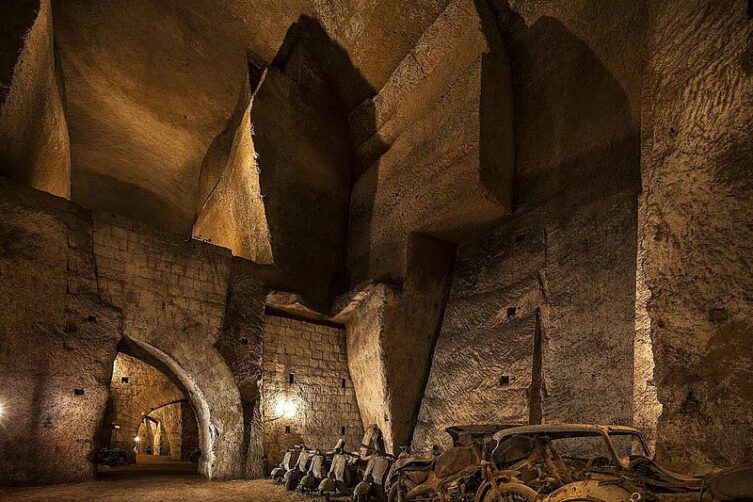
photo: galleriaborbonica.com on terms CC BY-SA 4.0
The idea of building a tunnel by Ferdinand II of Bourbon was driven by fear. Fear of a repeat of the situation that happened during the rebellion that took place over 200 years earlier (in 1647). Ferdinand II of Bourbon knew this story well.
Naples was then under the rule of the Spaniards, who struggled with financial problems and treated the city as a good source of income. They raised the already existing high taxes and imposed new ones. A huge city with over 300 inhabitants generated a river of money, but the atmosphere of rebellion and social tension prevailing in the city (due to too high taxes) needed only a small pretext to lead to the outbreak of the uprising. This is what happened on July 7, 1647, when, at the instigation of Masaniello (the son of a fisherman from Amalfi), two of his relatives refused to pay higher taxes at the fruit market. A group of thugs organized earlier (also by Masaniello) initiated a demonstration in defense of the rebels, and the incited crowd first threw fruits at the police who arrived, and then, in a group of about a thousand people, took over and plundered the armory and seized the city prison, freeing the people imprisoned there.
In a short time, the growing and armed mob led by Masaniello took control of the city, and the viceroy of Naples (Rodrigo Ponce de León) was practically cut off from the outside world and imprisoned in the Royal Palace. It was only by great luck that he finally managed to escape from the enraged mob to a nearby monastery.
When more than two hundred years later, from 1847, the Sicilian-Naples land began to be shaken by successive revolts and rebellions (which were, in a way, the announcement of the Spring of Nations, which swept across Europe a little later), Ferdinand II of Bourbon decided to take care of his safety. So he decided to build a tunnel that would connect the royal palace with the military garrison in Via Morelli.
The idea was simple: it was necessary to connect the palace and the garrison with an underground passage so that it was possible to quickly move troops from the garrison to defend the palace, and at the same time enable a quick and safe escape from the palace to the garrison army and then to another safe place.
Ultimately, the drilling of the tunnel was not completed and it ends right at the threshold of the royal palace (there is no connection to the palace). During World War II, it was a perfect safe haven, and after the war it became a warehouse willingly used by the local court. Goods confiscated from debtors were stored in it, including cars, motorbikes, etc. They remain in the tunnel to this day, creating an amazing scenery inside.
check out: entrance ticket to the Bourbon Tunnel (Classic Route) – [click]
Main entrance to Galleria Borbonica (from Via Morelli):
Tour routes:
– Tour Classico (Classic Route)
– Percorso Avventura (Adventure Route)
– Percorso Speleo Light (Speleo Route)
entrance address: Via D. Morelli, 61
GPS coordinates of the entrance:
40°49’58.2″N 14°14’36.3″E
40.832834, 14.243427 - click and route
21. Spanish Quarter (Quartieri Spagnoli)
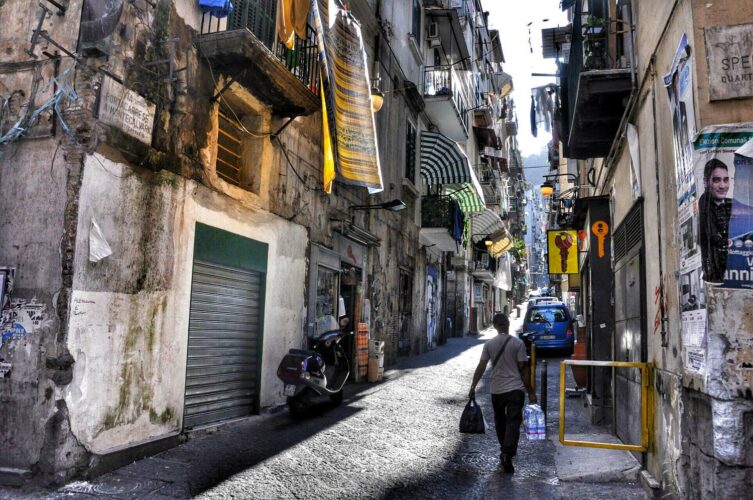
The Spanish Quarter is one of the most interesting and characteristic areas of the city. It is visited not because it is beautiful, but quite the opposite. Objectively speaking, it's cramped, ugly and unkempt... but that's where its charm lies! This is what makes it unique and unique and attracts crowds of tourists from the farthest corners of the world like a magnet. Tightly packed, neglected buildings, narrow, almost claustrophobic streets packed everywhere with various equipment that should not be here .. Ubiquitous craft workshops, located in almost every, even the darkest hole. In addition, scooters meandering between people, laundry hanging over the streets, from which something sometimes drips on the head and tiny squares with stalls squeezed in wherever possible.
It only takes a few moments to get used to it and stop seeing superficial ugliness, and see and feel the real atmosphere of the Spanish district. I strongly recommend giving yourself some time in this place and let your eyes and curiosity get carried away, walking around the district without planning anything. Just put them where you want and that's it.
The name of the district was created naturally thanks to the Spaniards living in this area. It was here that the military garrison was located, which provided military support during the Spanish rule over the area. Thus, it was here that Spanish soldiers and other newcomers from Spain settled most willingly with their families. Over time, there were so many of them that the area gained the name of the "Spanish district", although in the official administrative plan, such a district does not exist at all (it is located in districts I and II). The usual name, however, is stronger than the official plans and everyone in Naples knows where the "Spanish Quarter" is. It will be much harder for you to find someone who knows where district I or II is 🙂
Central point of the Spanish Quarter, GPS coordinates:
This is a landmark you don't need to go to. I am giving it only for better orientation in the field.
40°50’28.6″N 14°14’49.9″E
40.841285, 14.247183 - click and route
22. Largo Maradona
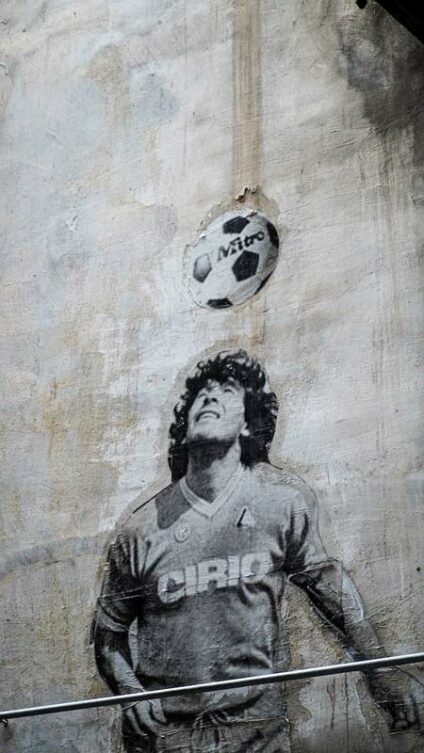
photo: Jack hunter
Maradona joined SSC Napoli in 1984. The club was not in a good financial situation, and Maradona was playing for FC Barcelona at the time and did not shine at all on the pitch. Despite this, the Naples club made a risky decision: they paid a record-high, staggering sum of over $ 10 million at the time, buying Maradona from Barcelona. At that time, no one knew yet that the golden era of the club and the player had just begun. During Maradona's time at Napoli, the club won its only Italian championship in its history (1987, 1990) and the UEFA Cup (1989), as well as the Coppa Italia (1987) and Supercoppa Italiana (1990).
At the same time, Maradona reached for the highest laurels in the Argentina national team, winning the World Cup in 1986, and then in 1990 the runner-up in the World Cup.
The golden era of Napoli and Maradona came to an end when their paths parted in 1991. However, the emotional connection between the player, the club and the city has remained forever, and its trace is perfectly visible in the city. Naples treats Maradona as a saint, displaying the footballer's lock of hair as a relic in a street display case at the Nilo bar on Via San Biagio Dei Librai 3 (the historic center of Naples between number (7) Via S. Gregorio Armeno and number (8) Cappella Sansevero) .
In the Spanish district there is Largo Maradona, the central place of the footballer's cult, with a large mural and a bazaar of shirts and memorabilia related to the footballer. The place is quaint and interesting even for someone who is not interested in football. The mere fact of such adoration is interesting, and the observation of the phenomenon is addictive.
Largo Maradona, GPS coordinates:
40°50’29.1″N 14°14’42.3″E
40.841409, 14.245077 - click and route
23. Montesanto (train station)
After a walk through the Spanish district, it's time to ride one of the next ones that help the city's inhabitants overcome large differences in elevation. The cable car will help us get to the castle hill, where there is an interesting viewpoint. By the way, the ride can be treated as another tourist attraction.
If you have a valid all-day ticket, which I mentioned in the first part of the entry, where I discussed the topic of public transport in the city, it is also valid in this queue and you do not need to copy a new ticket. However, if you use single tickets, first I invite you to the ticket office, and then we go up: direction Morghen station.
Funicular station - Montesanto, GPS coordinates:
40°50’50.0″N 14°14’45.0″E
40.847222, 14.245836 - click and route
24. Morghen (train station)
The upper station of the cable car, where you have to get off to be the closest to the viewpoint that interests us. After visiting the Belvedere San Martino viewpoint (25), we return to the same place and go down to the lower cable car station (Montesanto). The further itinerary depends on your willingness, strength and available time. If you want to end your sightseeing for today, you can go to the metro station (L2 - blue line stops at the funicular and Montesanto station, the nearest station of the L1 - yellow line is the nearby Dante station) and by metro, wherever you feel like: for food, drink or rest at the hotel.
If you have the strength to explore further, then ... I recommend entering the metro station at Montesanto and taking the L2 (blue) line to the Cavour station, from where we will continue our sightseeing.
Railway station - Morghen, GPS coordinates:
40°50’39.1″N 14°14’09.3″E
40.844194, 14.235917 - click and route
25. Belvedere San Martino
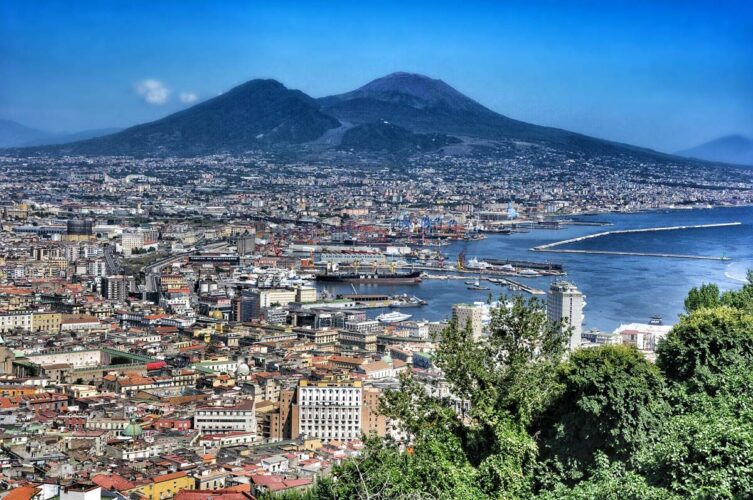
Here, a short piece of information is enough: Belvedere San Martino is a vantage point from which the most beautiful panorama of the city and the surroundings of Naples is available, including the Bay of Naples and the Vesuvius volcano towering over the area. It's hard to find a better place to see it all at once. Take a drink from your backpack, a sandwich, sit down and quietly eat and watch! It's for what!
Belvedere San Martino viewpoint, GPS coordinates:
40°50’38.8″N 14°14’26.6″E
40.844116, 14.240723 - click and route
26. Naples Piazza Cavour (subway)
Cavour metro station is the place where we start the last stage of our sightseeing itinerary. From here you can go both ways. If you have enough energy and like museums, you can first go to the archaeological museum Museo Archeologico Nazionale di Napoli (27), then go towards the catacombs of San Gennaro (31) and from there return via the catacombs of San Gaudioso (30), the palace of San Felice (29) and Palazzo dello Spagnolo (28), to Cavour station.
You can also do the opposite, i.e. from Cavour (26) go one by one through 28, 29, 30, 31 and only on the way back decide if you still want to visit the archaeological museum (27). In both cases, at the end of your tour, you'll find yourself near a metro station, allowing you to quickly return to your accommodation.
Cavour Metro Station, GPS coordinates:
40°51’19.2″N 14°15’18.6″E
40.855328, 14.255154 - click and route
27. National Archaeological Museum (Museo Archeologico Nazionale di Napoli)
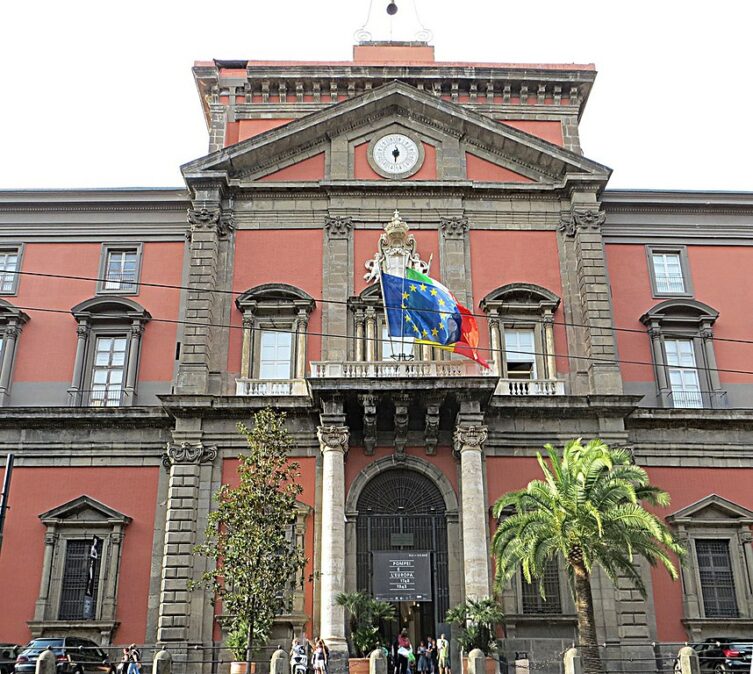
photo: Mister No according to CC BY 3.0
It is possible that this information will be surprising, but the Archaeological Museum in Naples, due to its collections, is considered one of the most important museums in the world. Here you will find the world's largest collection of classical Greco-Roman art (including Roman painting), collections of art from Pompeii and the Vesuvius area, and a collection of over 18 (!!) Egyptian artefacts (sarcophagi, mummies, artifacts, tomb furnishings, etc.). ).
The collection gathered in the museum was created mostly from private collections bought or donated to the museum (among others, there are collections gathered here by the Borgia, Santangelo, Stevens and Spinelli families).
check out: tickets to the National Archaeological Museum – [click]
Curiosity:
During World War II, a group of the most valuable works of art gathered in Naples, fearing damage or theft, were packed and taken to Rome and the Vatican. Here, however, the German troops came across them. The find was looted and transported to Berlin, enlarging Hitler's private collection. Over time, as the war progressed, when Berlin became a city in real danger of bombing, Hitler decided to take the collected works of art out of the city and hide them in a safe place. The underground corridors of the Austrian salt mine in Altaussee were chosen as a safe hiding place (the underground art warehouse has been preserved and is open to the public here).
The mine in Altaussee quickly turned into a huge warehouse and works of art from many cities throughout the Third Reich began to arrive there. The total number of exhibits collected in the mine is difficult to estimate, but according to some, it could have reached up to 30 pieces, although the number of about 000 to 7 exhibits is more often assumed.
One way or another, we are talking about thousands of pieces of the greatest works of art in the history of mankind.
The unfavorable course of the war for Hitler meant that on March 19, 1945, Hitler issued the so-called Nero's order. This order ordered the ruthless destruction of everything that the enemy could use in any way. The art depository in the Altaussee salt mine met the criteria of Nero's order and was to be completely destroyed. Thousands of works of art, the greatest artistic achievements of man, were to disappear from the face of the earth.
Eight wooden boxes were brought into the corridors of the mine with the inscription: Careful Marble, Do Not Drop! In fact, the crates contained eight half-tonne air bombs, which in a fraction of a second were to end the centuries-old history of the masterpieces collected in the mine.
When Hitler canceled the order a few days later, the fanatical Gauleiter August Eigruber, responsible for its implementation in Altaussee, decided to bring the matter to an end, ignoring the change of order. Nero's order itself contained a categorical record that all orders contrary to it were invalid. The countdown has begun. An explosion could happen at any moment. Blowing up the mine, however, was not convenient for the workers employed in it and living in Altaussee. With its destruction, they lost their only source of income, and there were also those who could not even imagine destroying so many timeless works of art. The task of stopping August Eigruber, however, was not easy. Even reporting the case to Hitler himself and a direct order from Berlin did not help. Eigruber saw traitors everywhere and trusted no one. As he himself said, if necessary, he will throw grants into the mine himself and destroy everything himself.
In the end, there was no explosion. After many efforts, August Eigruber was intimidated. The bomb boxes were removed from the mine and deposited at a safe distance in the nearby forest, and the entrances to the mine were blown up, permanently blocking access to its interior.
On May 17, 1945, after five days of earthworks, the entrance to the mine was excavated, and a special unit of the American military, called "Monuments Men", or Defenders of Monuments, entered inside directed by George Clooney). After extraction, all works of art went first to the Central Collection Point in Munich, and after identification, to their original places. You will see some of them in the Museo Archeologico Nazionale di Napoli.
Naples Archaeological Museum, GPS coordinates:
40°51’11.9″N 14°15’02.2″E
40.853303, 14.250599 - click and route
Museo metro station near the Archaeological Museum, GPS coordinates:
40°51’13.6″N 14°15’06.8″E
40.853781, 14.251897 - click and route
28. The Spaniard's Palace (Palazzo dello Spagnolo)
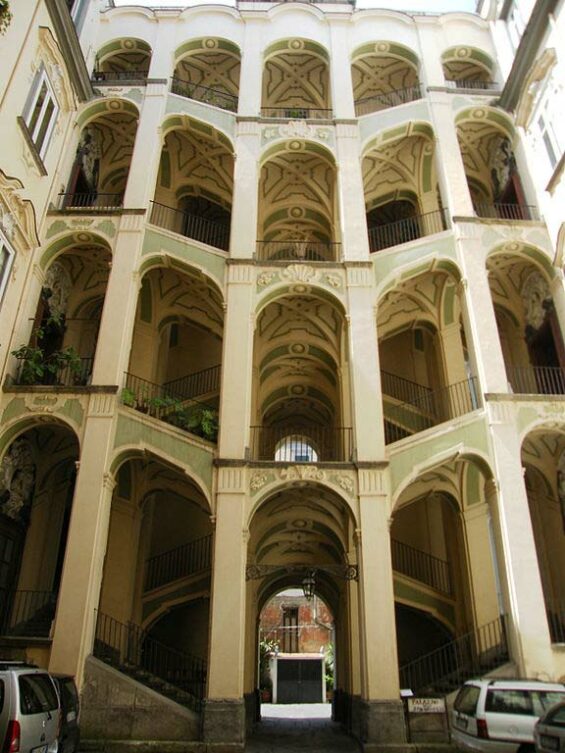
photo: Silvio Gaudenti according to CC BY-SA 2.0
The Spaniard's palace is the best and at the same time the most valuable example of the beautiful Neapolitan Baroque. The most spectacular is the symmetrical, richly decorated staircase, often called the "falcon's wings", visible from the side of the courtyard. The palace was built (in 1738) at the request of the Italian marquis Nicola Moscati, but it owes its current name (originally it was called Palazzo Moscati) to the next owner Tommaso Atienza, commonly known as "The Spaniard" (Atienza really was ... Spaniard 🙂 )
A similar style of staircases has more buildings in the city. These include: Palazzo Trabucco, Palazzo Venezia, Palazzo Sanfelice, Palazzo di Majo, Palazzo Tufarelli. We will see one of them at the next point of the trip.
The Spaniard's Palace (Palazzo dello Spagnolo), GPS coordinates:
40°51’24.9″N 14°15’16.2″E
40.856902, 14.254490 - click and route
29. San Felice Palace (Palazzo Sanfelice)
San Felice Palace, and basically Sanfelice, because its name comes from the name of the designer Ferdinando Sanfelice, it was created for the needs of the designer himself and his family.
The design and the building made such an impression that in later years Sanfelice got more commissions and thus the design designed by him, and described in the previous point, was created Spaniard's Palace. The idea of a staircase invented by Ferdinando has been an inspiration for many other projects and designers for many years.
San Felice Palace, GPS coordinates:
40°51’27.8″N 14°15’05.2″E
40.857712, 14.251440 - click and route
30. Catacombs of St. Gaudiosus (Catacombe di San Gaudioso)
Catacombs always evoke a lot of emotions. Such close communion with death and the ashes of our predecessors does not come easily to everyone. I belong to this group and I understand it perfectly. That doesn't mean I don't enter the catacombs. I do, but I always have to catch my breath afterward. It's usually a really great experience for me.
In the XNUMXrd century catacombs of St. Gaudiosus, the emotions are all the greater, because a special (for me quite macabre) form of burial is reserved here for the rich and influential people. This applies especially to the period, which can be roughly dated to the XNUMXth century. At that time, the Dominicans took care of the catacombs. According to their belief, the most important part of the human body was the head, where all human thoughts are gathered. This had important consequences.
Wealthy or distinguished people, having a chance to be buried here, could count on a special burial consisting in the fact that after death their body was thoroughly dried. Then the head was separated from the rest of the body. The body was placed in a separate crypt, and the head was embedded in the wall (so that the face protruded from the wall and remained visible). The rest of the silhouette was painted on the wall under the face (more or less as in the photo below).
Today in the catacombs you can only see paintings of silhouettes, and this type of burial has been discontinued for hygienic reasons.
You enter the catacombs through the Basilica of Santa Maria della Sanita.
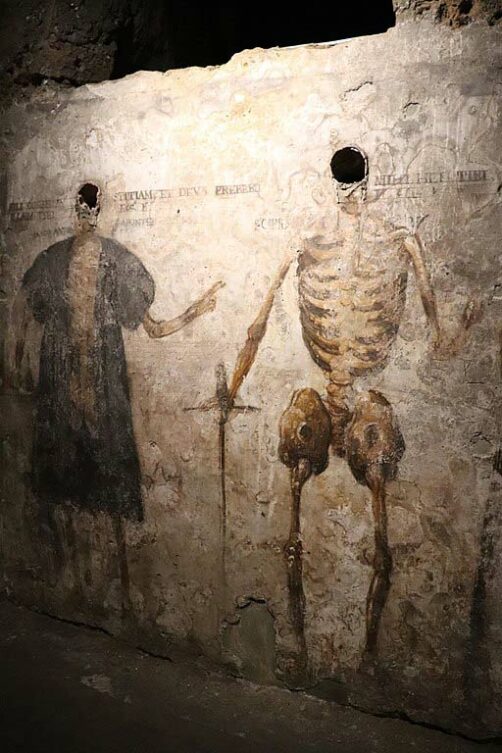
photo: Fabien Bièvre-Perrin according to CC BY-SA 4.0
Catacombs of St. Gaudiosusa (entrance through the Basilica of Santa Maria della Sanita), GPS coordinates:
40°51’34.4″N 14°14’57.0″E
40.859547, 14.249175 - click and route
31. San Gennaro Catacombs
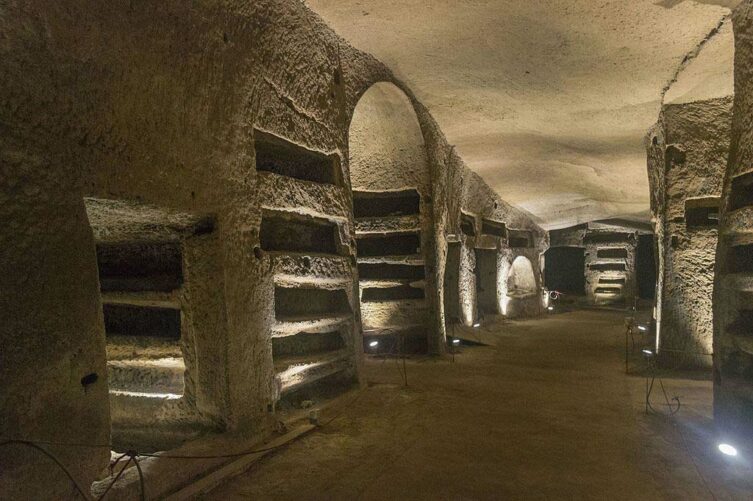
photo: Dominik Matus according to CC BY-SA 4.0
The Catacombs of San Gennaro are located in close proximity to the Catacombs of St. Gaudiosus, and you'd think it would be a repeat of what we've already seen. Nothing more wrong! San Gennaro is a place with a decidedly different expression and other dominant emotions. After the cramped and claustrophobic catacombs under the Basilica of Santa Maria della Sanita, here we are dealing with a large, two-level complex carved in soft tuff rock, occupying a large area under the Rione Sanita district. The Catacombs of San Gennaro are often called the "Valley of the Dead". In their current shape, they were created from the merger of three separate cemeteries. The oldest, located on the lower level, fragment comes from the XNUMXrd - XNUMXth century AD. The upper level was conceived and constructed in such a way as to connect the neighboring cemeteries into one large necropolis.
Curiosity:
During World War II, the catacombs were used as an air-raid shelter.
San Gennaro Catacombs, GPS coordinates:
40°51’54.2″N 14°14’50.4″E
40.865061, 14.247337 - click and route
32. Underground Naples LAES
Tours are run by the second most popular association in Naples with official permission to conduct this type of activity in the city: the LAES Association. The tours lead in the underground dug out somewhere between the Spanish Quarter and the Royal Palace.
The meeting point is in Piazza Trieste e Trento, in front of Gran Caffe Gambrinus. The coordinates of the meeting point and the ticket booking form can be found below.
.
LAES meeting point in front of Gran Caffe Gambrinus, GPS coordinates:
40°50’12.5″N 14°14’54.8″E
40.836799, 14.248555 - click and route
Naples - hotels and accommodation
Naples gives you great freedom in choosing accommodation. From the cheapest to quite expensive and exclusive. It's up to you which option you choose. You can also often find high-class accommodation at a very affordable price. You just have to search.
The easiest way is to start with this link - [click].
https://www.booking.com/searchresults.en.html?city=-122902&aid=1725593&no_rooms=1&group_adults=2&room1=A%2CA
The link has been prepared in such a way that it filters accommodation offers limiting them only to Naples. A few suggestions found from this very link are listed below. It's also a good idea to click from any of the hotels listed below. Then a page with this hotel and several others similar to it will open. A convenient and helpful option.
The suggestions below are not the "only recommended", "selected" and "best in town" ... There is no chance that everyone will fit in one or even four recommended hotels 🙂 They are a great starting point for your own search, and in There are a lot of good hotels and accommodation in Naples. Just click, search, choose and explore!
Agora' dei Mille – [click]
Napoli a Festa – [click]
Terrazza Garibaldi – [click]
Relais Castel Nuovo – [click]
Important to me!
Give the article a good rating (5 stars welcome 😀)!It's free, a for me it is very important! The blog lives on visits and thus has a chance to develop. Please do it and ... thank you in advance!
If you like my guides, you will certainly find the one I created useful guide catalog - [click]. There you will find ready-made ideas for your next trips, descriptions of other tourist destinations and an alphabetical list of guides divided into countries, cities, islands and geographical regions.
I also post link to Facebook profile - [click]. Come in and press "Follow"then you will not miss new, inspiring posts.
Unless you prefer Instagram. I'm not a social media demon, but you can always count on something nice to look at on my instagram profile - [click]. The profile will gladly accept any follower who likes it.
I make the content I create available free of charge with copyright, and the blog survives from advertising and affiliate cooperation. So, automatic ads will be displayed in the content of the articles, and some links are affiliate links. This has no effect on the final price of the service or product, but I may earn a commission for displaying ads or following certain links. I only recommend services and products that I find good and helpful. Since the beginning of the blog's existence, I have not published any sponsored article.
Some of the readers who found the information here very helpful, sometimes ask me how you can support the blog? I do not run fundraisers or support programs (type: patronite, zrzutka or "buy coffee"). The best way is to use links. It costs you nothing, and support for the blog is self-generating.
Pozdrawiam

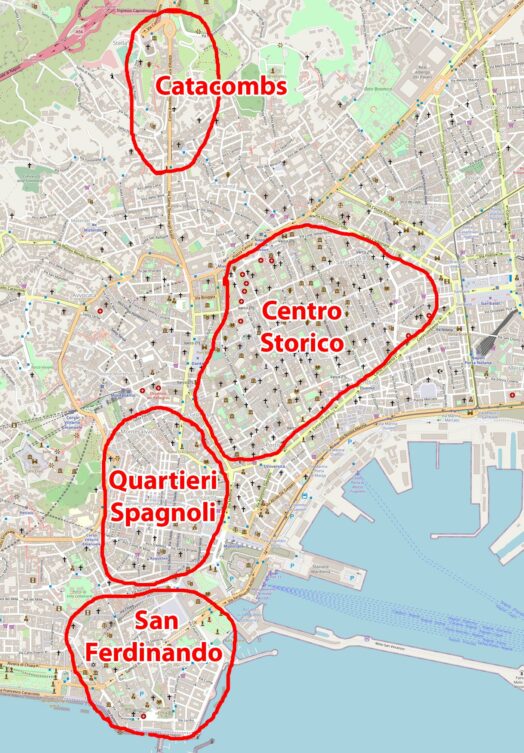

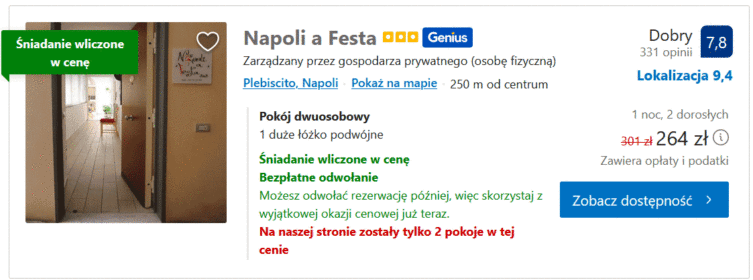

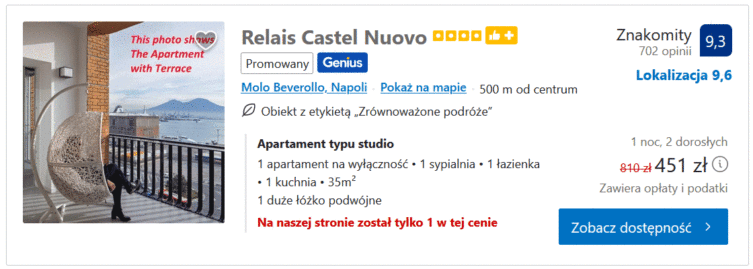
Amazing blog. All places worth visiting are described in great detail. Plus maps, addresses, curiosities, prices!!!! My congratulations. We are just going to the Naples area and I must admit that this is the quintessence of all the blogs I have read about Naples so far. Thank you and best regards.
Have fun exploring and thank you!
: )
Thank you very much for the work you put into this article!
A great plan to use. Maps are especially helpful. Thanks.
Everything described is great, I already feel like I was there, and the trip is ahead of me. I can't wait 🤗😊
Really great blog - I've been looking for something like this for a long time. You can use this information to create your own customized itinerary. WAY TO GO!!!!
I traveled with Mr. Jacek around Madeira, wonderfully precise routes, a lot of information, advice, better than guidebooks. Thanks. Mr. Jacek.
Now I have read your proposals of Naples and Rome.
I'm going tomorrow and I'll definitely use the valuable tips. Thanks
The best guide I've been looking for. Thank you very much for such detailed descriptions, instructions, order. They helped me a lot during my trip to Naples. Regards.
We have just returned from Naples using your sightseeing itinerary. Is fantastic. Readable and transparent. Thank you for the opportunity to benefit from your hard work!!
Cool! Thank you for this opinion.
It's very important for other readers to know they can trust this data.
I'm glad everything worked out and best regards!
Excellent blog. Thank you very much for a great itinerary for visiting Naples, which I will definitely use soon. Everything is described in an interesting way and the GPS location at the attractions is a great way to get to the place. Congratulations on the idea, but also a light and cool pen. I will also be happy to read other descriptions of places that will inspire me to make further trips.
Thank you and best regards.
Meeeh job. All points saved in Google maps and in September we start according to the list you posted here. Thank you for your time and heart. Karma is coming back. Regards and Fart!
Next week I'm going to Naples and I'll do it with your map. She is sensational!
I'm going to Naples right now. I used to work there a long time ago and explored the city quite well. Now I'm going with my son. Your guide is a revelation! I will definitely use it, because you served everything "as if on a plate".
Thanks alot !
Thank you very much. I only have 2 days in Naples and I didn't know how to plan the routes so as not to exhaust the children on the first day. Fantastic tips and descriptions.
ADOREI todo o teu roteiro por Napoles!!!! A riqueza de detailhes é incrivel! Que bom se eu encontrasse roteiros prontos assim para todos os lugares da Italia para os quais irei!
I am going to Naples, I am very excited after reading this blog. The best I've read.
Mr. Jack
I am going to Naples for a week from 05.09/12.09.23 to XNUMX/XNUMX/XNUMX. I will be sure to follow your excellent instructions. Thank you
Great blog and article 🙂
Great post with excellent instructions and unique value, very helpful! We are going to Naples and the Amalfi Coast the coming October, and we 'd be happy to borrow your PLANs for reference. Thank you so much!
Enjoy the trip and thank You
Great information. I was in Naples, but I didn't know anything about many places. I'm going again and your information will make it much easier. Thank you very much and regards
Irena
Hello
I'm just going to Naples, I didn't know how to organize the sightseeing, and thanks to your wonderful work, I have a ready plan with a lot of interesting information. A lot of work. Thank you very much and best regards, Natalia
Thank you for your work!!! This is what I was looking for, this is a compendium of knowledge about Naples! Great routes, maps, sightseeing suggestions :-) - I'm going to Naples in 4 days and your plan will accompany us 😉
With best regards. Monika
Next week I'm flying to Naples for the first time and I already know that I will explore it with the map you prepared. Thank you for such detailed and fantastic information - it's everything I needed. Great job!! Congratulations
A great sightseeing plan.
Very interesting and helpful article
A very good guide!
My friend and I were able to find our way to Naples easily and quickly. Lots of valuable advice and tips!
Thank you:)
Great guide! If you have noticed an increased number of views in recent days, it was me and my husband. 🙂 We ran around Naples with this guide, and the best idea is to provide GPS coordinates. Great idea!
heh heh...
I thought it was you 😉
but don't worry... the blog lives on visits, so I invite you again next time, in another location!
and recommend to others!
One more month until departure... I'll carve out even the coordinates on a sheet of metal :)
Thank you for your work!
I don't know where to click on the stars? 🙁
I've read the beginning and I'm already excited! Out of curiosity, when was this entry created?
2023
THANKS TO THE LORD, I ALREADY LOVE NAPLES, BUT EVERYTHING IS JUST AHEAD OF ME!
Great blog. We're going in some time. I haven't seen such detailed descriptions with photos before. Thank you very much, I will write to you after my return because we intend to stick to the plan in detail.
Best regards, Iwona
Thank you very much for the extensive information. I'm going tomorrow, so I'll definitely use the tips provided
In short, AWESOME!!!!!!!!!!!!!!!! I'm going to Naples right now, I'll definitely use it
Fantastic guide! A huge contribution of work! And these links! We are going to Naples right now, so we are taking you (work) with us.